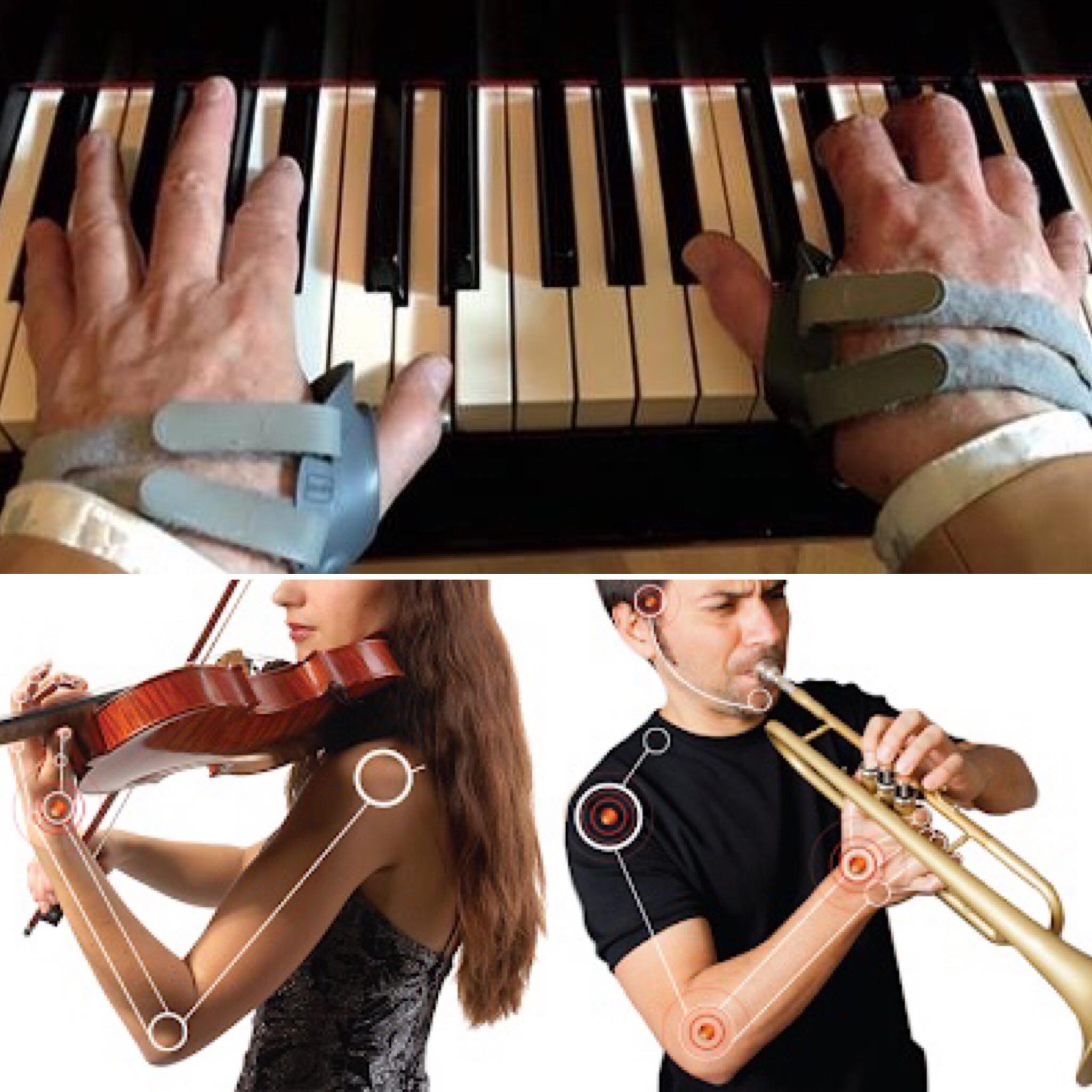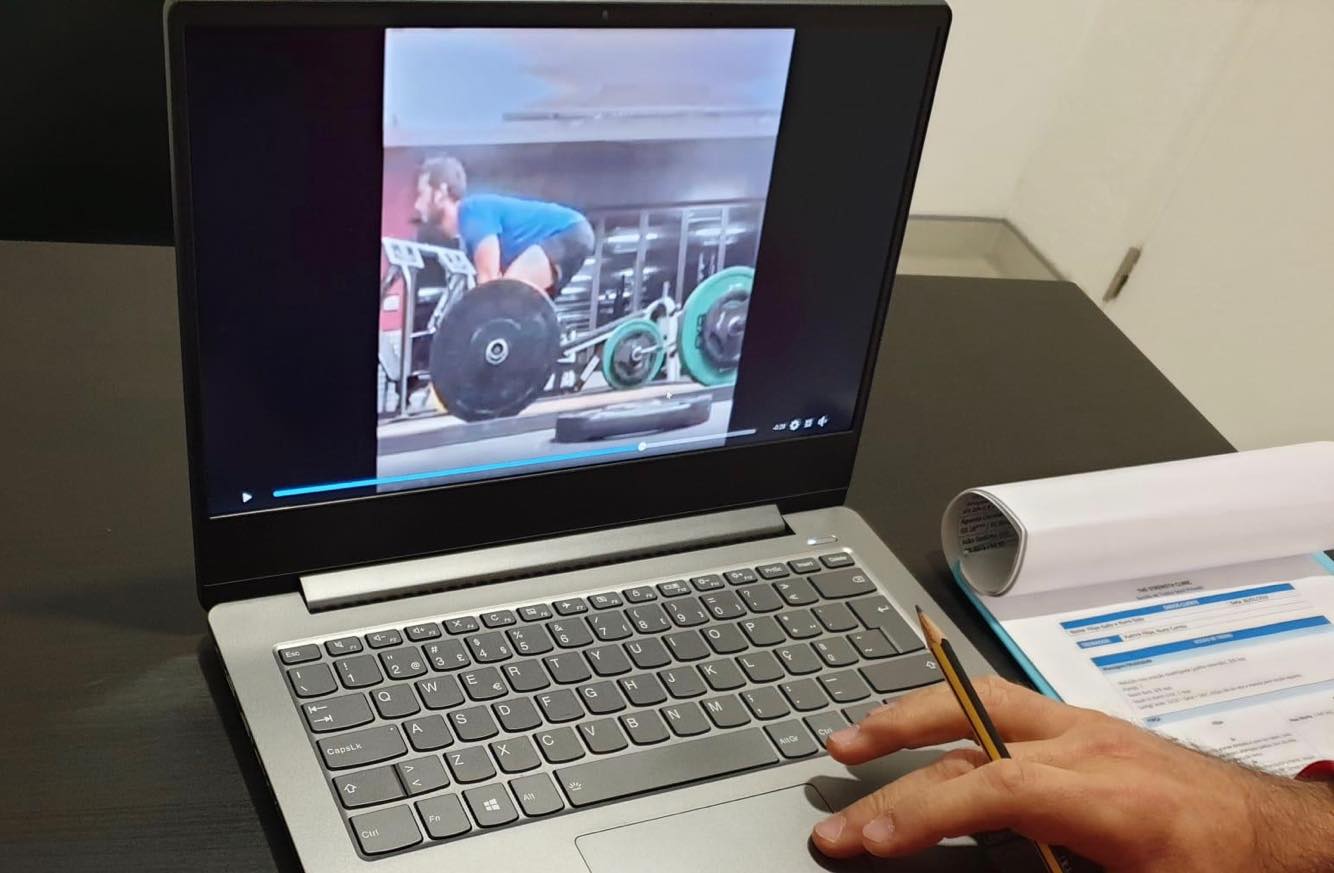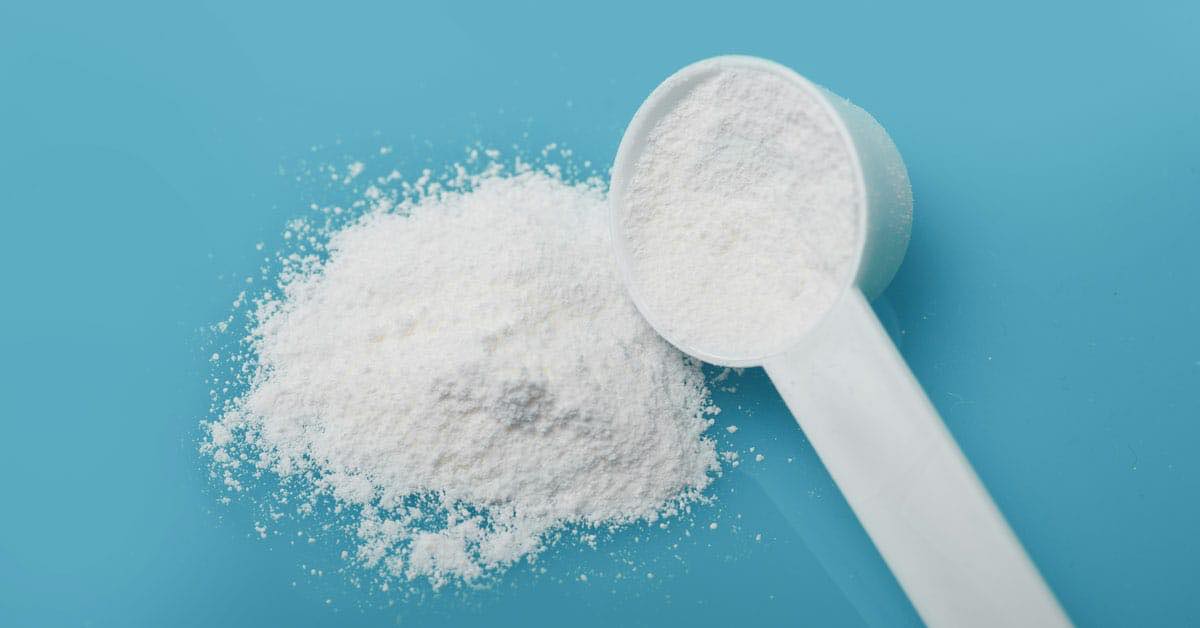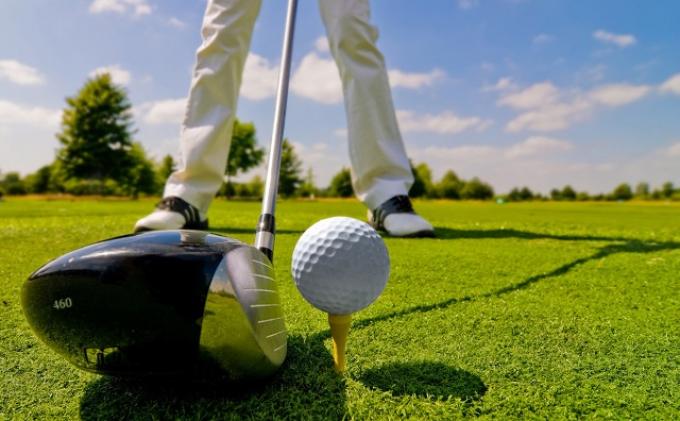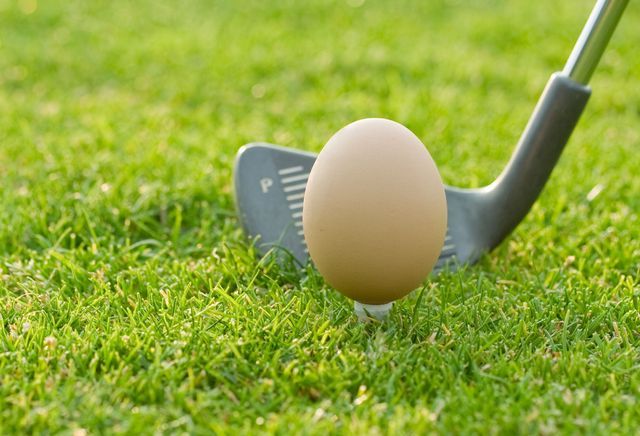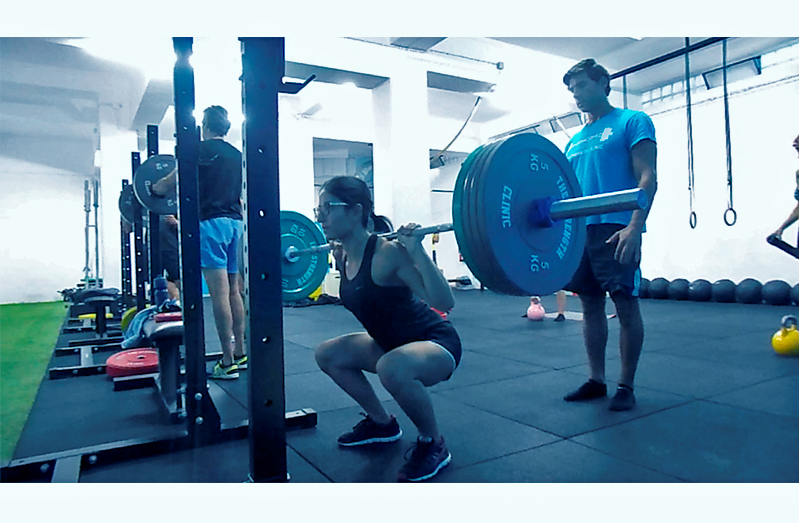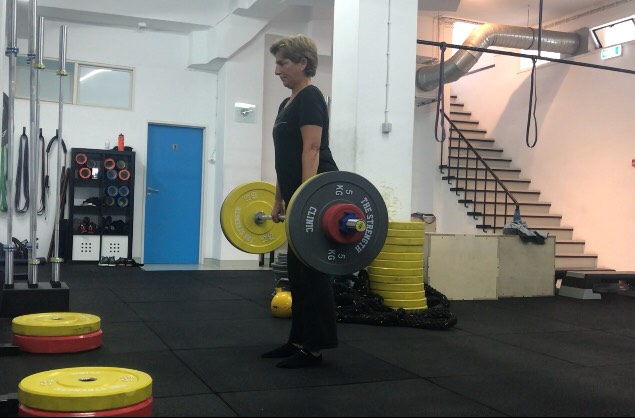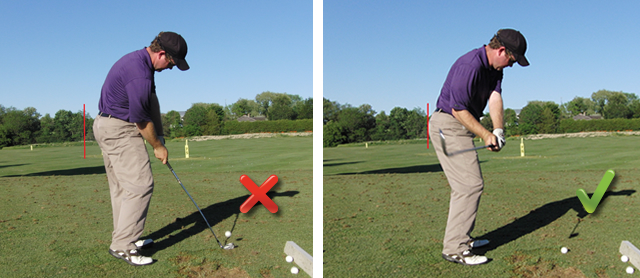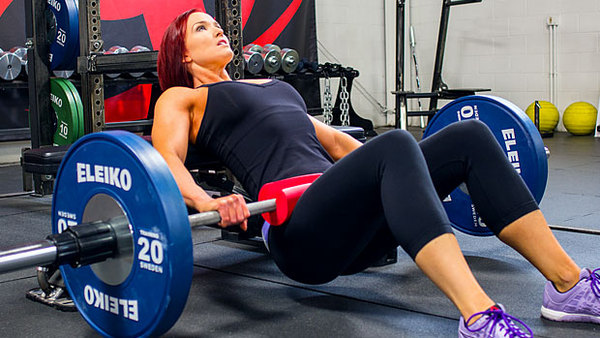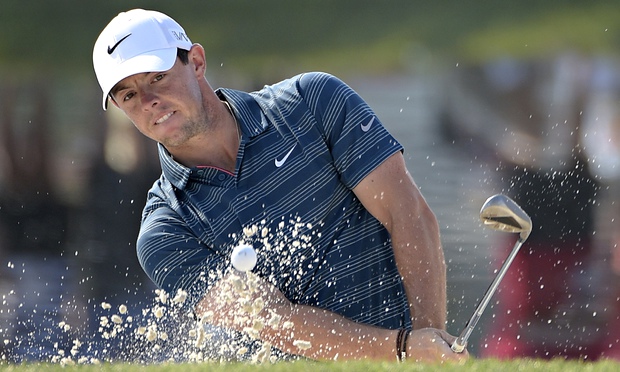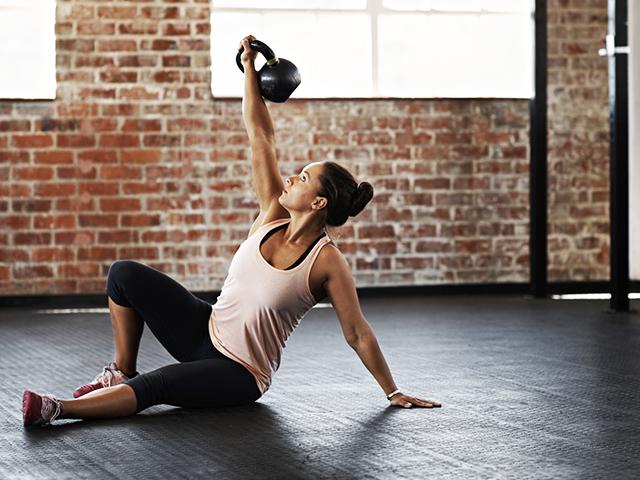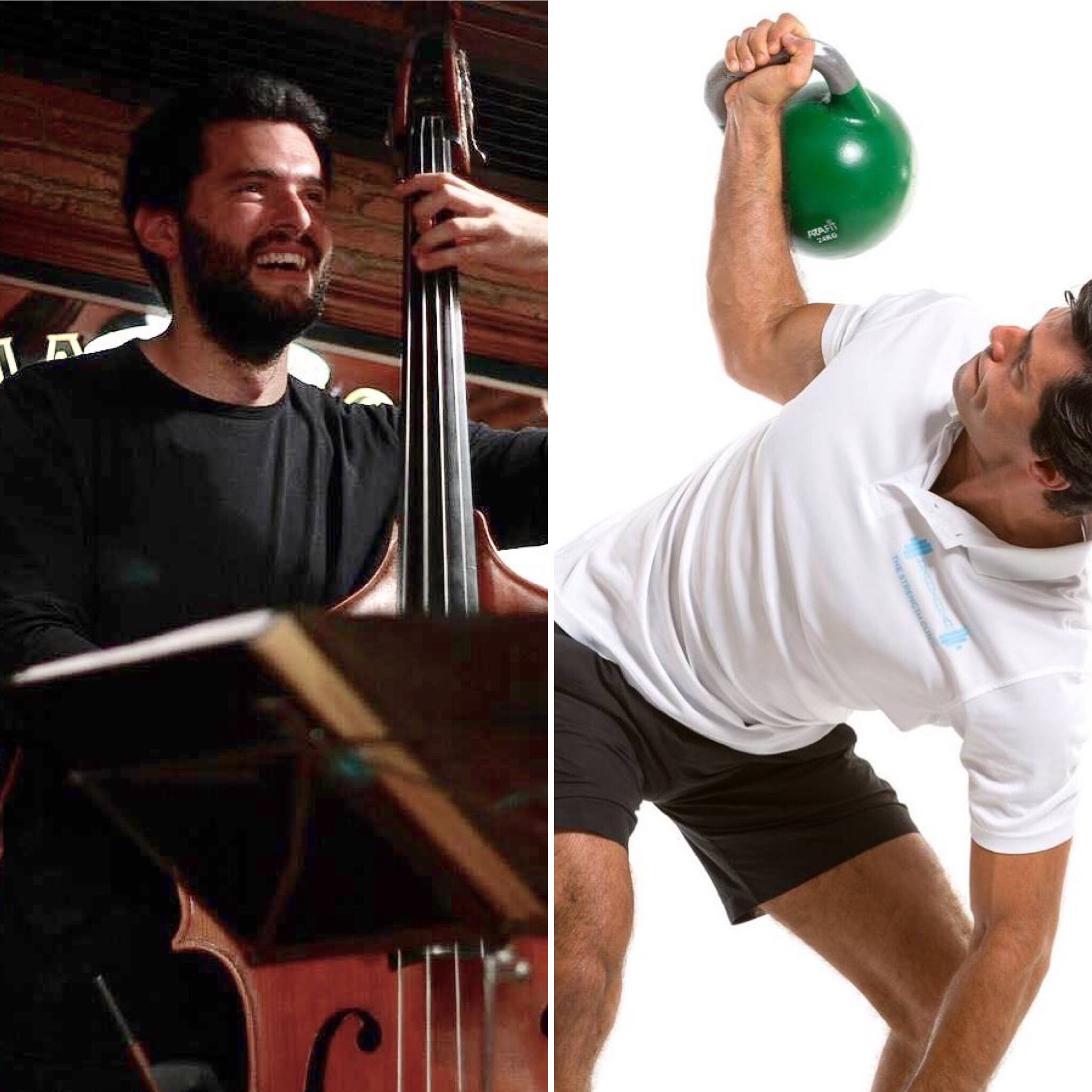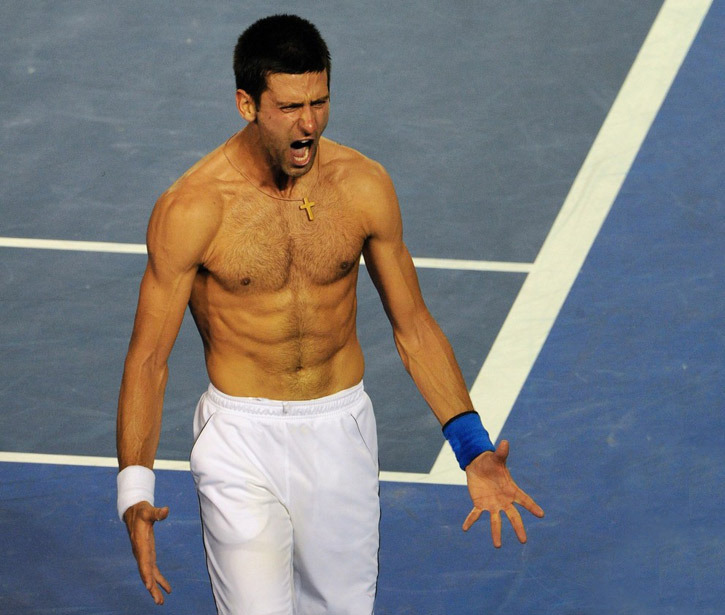Musicians as athletes
I affirm this with the conviction of someone who knows these two universes well: musicians are high-performance athletes, but they do not treat themselves as such. Professional musical performance and high-performance sports require very similar levels of commitment, as well as physical and mental demands. The time, commitment and consistency required to achieve a high level of performance playing an instrument or performing a specific sport skill have much more in common than one might initially think. Some differences will lie in the fact that, in general, neuromuscular recruitment associated with playing an instrument has a greater focus on fine motor skills (i.e. short movements of greater precision and performed mainly with the limbs extremities) and less at the level of gross motor skills (i.e. larger movements involving larger muscle groups) that we normally associate with sports movements. However, it should be clarified that both large muscle groups play an important role, particularly at a postural level, in instrumental performance, and the smaller muscles associated with fine motor skills also play a fundamental role in most sports movements.
For example, if we establish a parallel between playing the violin and performing a given sport specific skill in tennis, we find that, although at different levels, a balance of fine and gross motor control is necessary for better performance in both activities. When we play the violin, we want to maintain a high and controlled posture so that holding the violin with the non-dominant arm and handling the bow with the dominant arm allows the fine work of the hands and fingers to occur as efficiently as possible. Now, if the musculature involved in the stabilization of the trunk and in the elevation of the arms is weak, fatigue sets in more quickly resulting in postural loss, in an execution carried out with greater muscle tension and consequently in a worse performance. In the case of the serve in tennis, due to the high demand for motor coordination and strength involving all the large muscle groups of the lower and upper body, there is also a need for high levels of fine motor skills coordination regarding wrist, hand and finger movements, in order to implement a given spin effect and the desired direction to the ball.
In fact, both musical and sports performance involve neuromuscular recruitment to produce movement and work that requires precision, speed, endurance and strength. In addition, and particularly at a professional level, playing an instrument and playing a sport are activities that require long hours of repetitive movements that, combined with poor physical conditioning, can lead to a variety of clinical conditions. It is unthinkable that a highly competitive athlete does not follow a training program targeting the development of his/her physical qualities which should be complementary to the practice of his/her sport. It is easy to recognize that a good physical fitness level will ensure greater resilience and longevity in sports. The same applies to musical performance. Musicians are high-performance athletes and should prepare themselves as such! Living and playing with pain is not inevitable, it is an option.
The prevalence of pain and injury in musicians
As the years go by and the hours playing their instrument accumulate, it is almost inevitable that professional musicians develop musculoskeletal and/or neuromuscular problems of varying severity at some point in their career. More so if they do nothing about their physical preparation. Review studies on the prevalence of injuries in professional musicians point out that 76% of musicians suffer or have suffered from physical problems that prevent them from performing at their usual level and 84% had injuries that interfered negatively with their musical practice1. Some musicians will develop tendinopathies and low back pain of varying intensity, which they will be able to manage with chronic intake of anti-inflammatory medications or simply by playing less frequently and/or just by enduring pain and discomfort. Others will develop more serious overuse injury syndromes that will become chronic and compromise not only quality of musical performance, but also quality of life, forcing them to periods of musical inactivity. Additionally, others will suffer from even more serious forms of injury that may result in abandoning their career as an instrumentalist musician.
In general, the most frequent injuries affecting musicians manifest themselves through pain and/or dysfunction, especially on the joints, tendons, ligaments and nerves of the upper limb, head, neck and spine. For example, in orchestral instrumentalists, injuries of musculoskeletal and/or neuromuscular origin are more common and affect about 64% musicians, of which 20% consist of peripheral nervous problems and about 8% of cases of focal dystonia2. It makes sense, considering that these are the most stressed areas of the body during instrumental practice. An exception would be the cases of focal dystonia, which, although it may be accompanied by pain and musculoskeletal injury, the root cause of the dysfunction observed at the peripheral level is actually central, that is, the dysfunctional neuronal circuits are at the upper levels of the central nervous system such as the cerebral cortex. Thus, the most frequent injuries in instrumentalist musicians can be summarized as follows3:
- Musculoskeletal injuries – epicondylitis, tendinopathies (tendinosis, tendinitis, tenosynovitis), bursitis, arthritis, arthrosis, osteoarthritis, contractures, injuries to the temporomandibular joint;
- Nerve trapping and inflammation – carpal tunnel syndrome, thoracic outlet syndrome, radial tunnel syndrome, ulnar nerve compression syndrome, ulnar tunnel syndrome, cervical and lumbar radiculopathies;
- Hypermobility;
- Focal dystonia;
- Hearing loss.
The onset of injuries in musicians is due to an array of factors that naturally interact. Several authors have identified the following factors facilitating and/or causing the development of injuries in musicians1:
- Physiological and biological factors such as gender and age. Women seem to be more likely to develop peripheral musculoskeletal and nerve injuries compared to men, and individuals who engage in high volume instrumental practice at an early age, at 4-5 years of age, are also more likely to develop injuries later in life4,5. In the case of focal dystonia, there is a clear higher prevalence in males (over 90%) and in women with menstrual disorders, which suggests that hormonal factors may be predisposing to the development of this disorder6.
- Type of instrument. The characteristics of the instrument (size, shape and weight) and the time of practice imply different levels of physical demand, in which fatigue onset and an execution based on too much physical effort can lead to the development of injuries7. For example, the position needed to play the clarinet implies that the entire weight of the instrument is supported on the right thumb, and at the same time it requires a large amount of short and fast movements of the fingers of both hands8. Another example particularly special to me is the double bass. A bulky instrument with an air column of considerable inertia, which requires not only considerable grip strength to press on the strings, but also considerable whole body physical effort (which, can of course, be optimized with efficient technique) to move this column of air and make the instrument vibrate and produce sound. Anyone who has tried playing the double bass for a few minutes realizes the physical demands that playing this instrument encompasses.
- Instrumental technique. A poor instrumental technique, with non-optimized positions, based on physical effort rather than on movement efficiency, associated with long hours of practice without rest, will naturally predispose the player to pain and injury, especially in the wrists, hands, neck and shoulders9 .
- Specific technical demands. The technical demands of a particular musical piece that often requires high-speed and high-intensity execution, with fatiguing repetition of movements or maintenance of extreme hand positions for a long period of time. All of this creates high levels of mechanical stress and may cause injury10,11.
- Body asymmetry. In the same way that an athlete of a one-side dominant sport will try to compensate for these asymmetries by working out both sides of the body, a musician is in a similar situation, because playing an instrument implies asymmetrical work in very unnatural positions for long periods of time, which will favor the occurrence of various muscular imbalances12.
- Poor physical fitness. Good levels of strength and general physical conditioning are essential to maintain a good position to play an instrument for long periods of time. Most of these positions are very unnatural. Being in good physical fitness will allow to resist the onset of fatigue, recover more quickly between rehearsals or practice sessions, and in fact, it will allow to tolerate more hours of practice avoiding technique and performance deterioration7. Muscle imbalances and weakness resulting from long hours of sitting in certain positions and high volume repetition of short movements must be prevented through exercise programs aiming to strengthen the body globally, and at the same time to compensate for muscle imbalances induced by instrumental practice13.
- Other lifestyle factors. We know that lifestyle factors such as smoking or smoke exposure, alcohol consumption, sleep deprivation, malnutrition, poor hydration and obesity have very damaging effects at a systemic level on our body. Regarding neuromuscular injuries, we know that all these forms of toxicity weaken the body’s connective tissue (cartilage, tendons, ligaments, membranes), muscles and nerve conduction, predisposing to the development of localized inflammatory processes as well as chronic injuries. For example, did you know that obesity is highly predisposing to development of carpal tunnel syndrome?14 Or that smoking is strongly associated with development of injuries and dysfunctions in the shoulder?15
Preventing and resolving injuries in musicians
Any elite athlete empirically knows something that has long been supported by science. That the most effective way to prevent (and also treat) overuse or overload injuries due to high volume sports practice is to ensure good levels of physical fitness combined with good recovery habits, adequate rest and nutrition. Regarding physical fitness, it is unthinkable for an elite athlete, not to follow a regular physical training program. An athlete knows that this will have negative consequences both on sports performance and on the susceptibility for developing injuries. The athlete knows that the weaker his/her musculoskeletal system is, the greater the vulnerability to injury. The question is, and if we consider that professional musicians are required to engage on activities requiring high physical and mental performance for long hours of daily practice, shouldn’t musicians treat themselves as high-performance athletes? I am certain that they should.
In fact, a 2019 systematic review investigating the topic of physical training for professional orchestra musicians1 indicates that following a structured physical training program of varying durations (from a few weeks to several months) has generally resulted in significant improvements in musical performance and in reducing (and even eliminating) chronic pain1.
To keep playing at the highest level for a long time, musicians would greatly benefit if they treated themselves as high-performance athletes and ensure that they maintain good physical shape combined with good habits of recovery, rest and nutrition. And to be clear, when I talk about staying in good physical shape, I don’t mean playing sports. In fact, playing sports as a mean to improve one’s physical fitness is not ideal and can even be harmful. More activity with asymmetric characteristics would be added on top of another, also asymmetric, which is playing a musical instrument. In general, all sports are constituted by specialized movements, and for that reason, also asymmetrical. So, except for purely recreational reasons (which can also be positive at a mental and stress release level), the practice of a sport as a strategy to improve physical fitness is not ideal and should not be the first choice particularly by musicians (I discuss this very topic in this article: Why musicians should not play sports).
General physical fitness is improved through the process of training our physical qualities. This should entail an assessment of the initial status in order to identify specific limitations and outline a specific intervention strategy. One should always start at the base and progress from there, just like the process of learning to play a musical instrument. Here, attention to detail is key. A well-designed training program implies the management of training variables specific to the profile and objectives of the athlete or, in this case, the musician. A correct selection of exercises is crucial, as well as close monitoring of their implementation regarding form of execution, training load and progression over time. As I mentioned, it is not very different from the process of learning to play a musical instrument!
For a musician, playing the instrument is the top priority. It can be obsessive, I know. But playing better in the long run does not necessarily mean playing more hours, but rather investing in taking care of the ‘’machine’’ that is our body. I reiterate once more that playing with pain or discomfort is an option and not an inevitability. Take care of your body and treat it well, because you will need it in the long run!
Train well to play well!
Nuno Correia
References:
- Gallego, C., Ros, C., Ruíz, L., Martín, J. (2019). The physical training for musicians. Systematic review. Sportis Sci J, 5 (3), 532-561.
- Lederman, R. J. (2003). Neuromuscular and musculoskeletal problems in instrumental musicians. Muscle & Nerve, 27(5), 549–561.
- Betancor Almeida, I. (2011). Hábitos de actividad física en músicos de orquestas sinfónicas profesionales: un análisis empírico de ámbito internaciona Tesis Doctoral. Universidad de Las Palmas de Gran Canaria, Las Palmas de Gran Canaria.
- Fishbein, M., Middlestadt, S., Ottati, V., Straus, S., y Ellis, A. (1988). Medical problems among ICSOM musicians: Overview of a national survey. Medical Problems of Performing Artists, 3(1), 1–8.
- Viaño, J. J. (2004). Estudio de la relación entre la apariciación de lesiones musculoesqueléticas en músicos instrumentistas y hábitos de actividad física y vida diaria. En III Congreso De La Asociación Española de Ciencias Del Deporte. Valencia: Universidad de A Coruña.
- Rosset-Llobet, J., Candia, V., Fàbregas, S., Ray, W., & Pascual-Leone, A. (2007). Secondary motor disturbances in 101 patients with musician’s dystonia. Journal of neurology, neurosurgery, and psychiatry, 78(9), 949–953.
- Sardá, E. (2003). En forma: ejercicios para músicos. Barcelona: Paidos.
- Thrasher, M., y Chesky, K. (1998). Medical problems of clarinetists: Results from the U.N.T. musician health survey. The Clarinet, 25(4), 24–27.
- Wynn, C. B. (2004). Managing the physical demands of musical performance. En Williamon A. (Ed.), Musical excellence: Strategies and techniques to enhance performance (pp. 41–60). Londres: Oxford University Press.
- Bejjani, F. J., Kaye, G. M., y Benham, M. (1996). Musculoskeletal and neuromuscular conditions of instrumental musicians. Archives of Physical Medicine and Rehabilitation, 77(4), 406–413.
- Mark, T., Gary, R., y Miles, T. (2003). What every pianist needs to know about the body: a manual for players of keyboard instruments: piano, organ, digital keyboard, harpsichord, clavichord. GIA Publications. Martín.
- Ackermann, B., Adams, R., y Marshall, E. (2002). Strength of endurance training for undergraduate music majors at a university? Medical Problems of Performing Artists, 17(1), 33– 41.
- Frabretti, C., y Gomide, M. F. (2010). A saúde dos músicos: dor na prática profissional de músicos de orquestra no ABCD paulista. Revista Brasileira de Saúde Ocupacional, 35(121), 33– 40.
- Shiri R, Pourmemari MH, Falah-Hassani K, Viikari-Juntura E. The effect of excess body mass on the risk of carpal tunnel syndrome: a meta-analysis of 58 studies. Obes Rev. 2015;16(12):1094-1104.
- Bishop, Julie Y. et al. (2015). Smoking Predisposes to Rotator Cuff Pathology and Shoulder Dysfunction: A Systematic Review. Arthroscopy, Volume 31, Issue 8, 1598 – 1605.
Given the times we live in, where social contact is limited, the promotion of online services in all professional areas proliferates. In fitness, it seems that it has suddenly been discovered that you can (and should) train every day and that you can train at home and/or on your own. It is incredible the explosion of posts on social media by personal trainers offering sequences of exercises for people to perform at home. We know that, for better health and resilience, it is essential to exercise every day, just as it is essential to eat well and maintain personal hygiene, but this has always been so and, therefore, it is not only a necessity of current times.
For this reason, posting an exercise line-up for everyone to perform is as valuable as posting a photo of a meal or of someone brushing their teeth. It serves as much to remind you that these activities are important, but the content is not, to a large extent, applicable to you reading this text. Much less when it comes to exercise. In fact, picking up the fork and knife to eat, or the act of brushing your teeth are less complex activities than performing most of the physical exercises that we often see proposed, let alone organizing them in a training session.
The health and resilience resulting from training is even more relevant in times of crisis such as the one we are experiencing now, but that health and resilience was mainly built months and years prior to this moment. Notably during those months and years that you consistently went to the gym to do your workout, often with personal sacrifice. It is hard to organize oneself in order to be able to train! We have family and work and it is sometimes difficult to reconcile all social and professional obligations with the time we choose to invest in our health and well-being, like in the case of training. Notice that now I’m using the term training.
Because many of you who are reading these lines have long understood the difference between “exercising” and training. Many of you have realized that “exercising” is better than nothing, but that training is at a higher level. Training is a process that requires the organization and management of a range of variables over time. It requires making a careful assessment of the initial condition, selecting specific exercises and the ways to perform them, observing and evaluating movement, and making the necessary adjustments (e.g. load, type and form of exercise execution) in order to ensure constant progression along the path towards health, performance and resilience. Training is not the same as ‘’doing exercises” always varied and without criteria just to maintain some physical activity. And because some of you understand this difference, you have come over the months and years that preceded today’s turbulent times to make organizational sacrifices in order to train. And you chose to invest a little more of your time and money, and regularly went to a gym to get a training service. A service in which a program is followed, the exercises are not chosen at random, and in which the progression in the loads used as well as the execution of the exercises is closely monitored by a coach.
All the benefits of personalized training are possible to obtain remotely via online. I believe that the in-person format will always be superior, but with good organization and commitment from both the coach and student, constant progression is possible, and this difference can be mitigated. How do we know this at The Strength Clinic? Because we’ve been doing it for years! In addition, personalized training followed online may even have some advantages over the face-to-face format, such as:
- Not having to go to the gym at any given time. This can be a great advantage for some people. If the self-discipline of following your training program is guaranteed, travel time and what it implies in organizational terms is saved. In addition, you can choose a training time slot that best fits your schedule without being conditioned by the availability of your coach;
- Greater consistency and commitment doing the exercises in your program. Since you can choose the time slot of your training session, you are less likely to miss it, as you will have more flexibility in adjusting the schedule if needed. This way, it is more likely that you reach the weekly training frequency that is desirable. In addition, as we recommend that you document on video a summary of each workout on an online platform so that your coach can observe, this also adds an additional sense of commitment to the session and the proper execution of the exercises;
- Better cost benefit. In fact, you will be able to enjoy almost all the benefits of having a personal trainer for a lower price because you will not have to pay for the running costs of the facility and its equipment usage where the in-person training session would take place;
- Train directly with your favorite coach. If the coach you would like to work with is not available in-person or his/her in-person rate is beyond your means, the online option will allow you to work directly with him for a lower price.
The message “don’t stop training even if you are at home or on your own” in the context of the crisis we are experiencing today is correct! However, this need did not arise today. It is something that should be part of our lives if we want to remain getting stronger and healthier forever. For this purpose, training is much better than just “exercising”, especially if you follow workouts taken from social media that do not take into account your specific profile, your body awareness and do not follow any criteria for exercise selection and future programming. It only serves the purpose of “moving the body” and getting tired in that moment or day, but it will not accomplish much more than that. Because training implies a process that is based on your goals and individual characteristics. In a training session, what you do today was based on what you did yesterday and what you are going to do in the future. And it is possible to continue to train online and reap all the benefits of personalized training, even at a distance. It requires a mutual commitment of the student and coach in a process that is joint. Your optimized personal development will always be our commitment at The Strength Clinic. We are here to guide you through this process rather that offering “one size fits all” workouts for everyone!
Stay strong!
Nuno Correia
The International Society of Sports Nutrition published in 2017 a position stand (see reference below) on the safety and efficacy of creatine supplementation in the context of exercise, sports and medicine.
Creatine supplementation, one of the most popular and studied nutritional supplements, has in fact been shown to be effective in improving athletic performance (especially in high intensity exercise) and inducing relevant training adaptations. The consequent increase in intramuscular creatine (and phosphocreatine) reserves facilitates the rapid re-synthesis of ATP, the so-called energy “currency” of the body, which is essential for almost every reaction in our body. Thus, the increased availability of creatine in the cell through supplementation contributes to improve performance because it increases the energy availability in order to exercise (i.e. muscle contraction) as well as a whole range of other muscle cell related reactions. Creatine supplementation can in fact enhance strength production, muscle work, accelerate recovery and help preventing injury.
Additionally, creatine supplementation appears to be highly safe and effective not only in athletes but also in non-athletes (such as the so-called exercise enthusiasts), as well as in various clinical populations. In fact, several studies (see ISSN article, reference below) point to benefits of creatine supplementation in various populations and clinical settings, such as:
– Accelerating injury rehabilitation (because it attenuates muscle atrophy);
– Protection of neuronal injuries (spinal and cerebral);
– Mitigation of debilitating consequences in people with congenital syndromes of creatine synthesis deficiency;
– Attenuating the progression of neurodegenerative diseases (e.g. Huntington’s disease, disease, Parkinson’s disease, mitochondrial diseases, amyotrophic lateral sclerosis);
– Prevention and / or improvement of bioenergetics in patients with myocardial ischemia or stroke victims;
– Improving metabolic and functional indicators associated with aging;
– Possible benefit during pregnancy for optimal growth, development and health of the fetus.
In conclusion, creatine does indeed appear to be a safe and beneficial nutritional supplement for a wide range of populations and ages. Indeed, this is a supplement that actually works!
Take creatine and power to you!
Nuno Correia
References:
Kreider, R.B. et al., 2017. International Society of Sports Nutrition position stand: safety and efficacy of creatine supplementation in exercise, sport, and medicine. Journal of the International Society of Sports Nutrition, 14(1), p.18. Available at: http://jissn.biomedcentral.com/articles/10.1186/s12970-017-0173-z.
In previous articles (check Part 1 and Part 2) we discussed the fact that while all golfers will do everything possible to change their game (buying new clubs and new balls), many overlook one of the most decisive factors for their physical and mental success – their nutrition; we have identified some of the main reasons why golfers never change and, finally, we have pointed out five important links between golf and proper nutrition. In this article, I will share with you my concerns about the so called “normal diet” and the five most important habits you should create to start nourishing your body better.
The Western Diet
The western diet is generally used to describe popular eating habits in the USA. As these eating habits are still very popular in Europe and other parts of the non-Western world, it will probably be necessary to find a new name for this type of “diet” in the coming years (perhaps the killer diet is a good name!).
But what is the “western diet?” Well, this “diet” can be briefly characterized by a high intake of processed foods, refined carbohydrates, sugar and hydrogenated fats; and a low intake of healthy fruits, vegetables and fats. It is this “western diet” that has been associated with most western diseases or diseases of civilization (examples: cardiovascular disease, obesity, diabetes, cancer, Alzheimer, Parkinson). Interestingly, this diet may also be responsible for increased violence and decreased cognitive test scores in school-age children (attention deficit disorder) and adults. Finally, this “western diet” has also been linked to bone loss (osteoporosis) and muscle wasting (sarcopenia) in adult individuals.
Let’s look at an example of a “normal athlete” daily menu before working with me.
Breakfast: Bowl of cereals and milk + Natural orange juice + Coffee with sugar
Snack 1: Mixed toast + Chocolate milk
Lunch: Chicken salad with mayonnaise and ketchup sauce + soda + ice cream
Snack 2: Slice of cake + Juice
Dinner: Grilled fish with vegetables + Baked potatoes + Glass of red wine + Dessert
For most people, this may even be considered a good day (and indeed there are some good things in this menu), but in the long run this type of eating will greatly compromise your health and performance. For this reason, we have to discuss this situation with the person and meet their real physiological and functional needs.
The Habits you must create
Before changing their diet, it is important that people start with a firm and solid foundation, and then make the necessary changes to optimize their health and performance. Most people (athletes included) want to start building a house from the roof down or building walls without paying attention to the quality of the soil. Any of these habits are simple enough, but just like any habit you want to create, it takes time to practice to assimilate the foundations of proper nutrition.
Habit 1 – Drink more water
Sometimes we talk about so much about food and forget about water, the most important element our bodies need to function properly. It is water that regulates all the functions of our body, including the activity of all solutes (the solid materials) dissolved in it. It is water that will actually allow the nutrients we consume to reach our cells and our organs. Aim to consume 1-2 glasses of water after waking up and to drink about 2 liters / day.
Habit 2 – Eat a protein source at every meal
Eating protein at every meal is critical. Of course, some “experts” will make you believe otherwise, suggesting that protein is somehow harmful to the kidneys, unnecessary, etc. However, I want to highlight the fact that what I am looking for my clients / athletes is the best of these three worlds: better health, better body and better performance – it will be very difficult to achieve these three with a suboptimal protein intake. Some examples include: eggs, meat, fish, chicken, turkey and shellfish.
Habit 3 – Eat vegetables at every meal
Your parents and / or grandparents are right – you need to eat vegetables to prevent disease! Evidence has shown that in addition to the micronutrients (vitamins and minerals) contained in vegetables, there are also phytochemicals that are essential for optimal physiological functioning. Vegetables will help improve the acid-base balance in the body, so my advice is eating all the vegetables you can!
Habit 4 – Eat a healthy fat sources at every meal
Fat (such as protein) is an essential macronutrient and so we have to ensure proper intake every day through our diet. There has been a lot of misconception about the effects of fat on diet but the truth is that fat can be our best friend when the goal is to lose fat mass, optimize the body’s physiological response and our health. Some examples of healthy fats include: fatty fish, nuts, seeds, extra virgin olive oil, coconut and avocado.
Habit 5 – Eat more vegetables with main meals and leave the other carbohydrates to the post workout window
Another way of saying this is: if you have fat to lose, you have to earn the right to eat carbohydrates by doing vigorous exercise in the first place! Do you want to keep eating bread, pasta, rice, potatoes, crackers, sugary foods, pizzas, sweets, etc.? You can even eat them – just make sure you do it in the post workout window (1-2 hours after training) because this is the time when your body is most sensitive to insulin. As for the quality of carbohydrates, you will have more benefits if you choose gluten-free foods (rice, quinoa, chestnuts, sweet potatoes, yams, potatoes) than highly processed foods or gluten-free junk foods. Also, don’t use exercise as an excuse to treat your body like the garbage truck!
Good strokes!
Pedro Correia
Ever wonder why most people eat so much alike? Milk and cereals for breakfast, a soup and a sandwich at lunchtime, and, with luck, a slightly more balanced dinner of meat or fish, rice and some vegetables? What about those mid-morning and/or afternoon coffee and toast snacks? Crackers? Cakes and sodas? Cereal bars? Do you think this is a coincidence? Of course not, this is no coincidence!
This only happens this way because that is how you were taught to eat. Maybe this is the way your parents eat. Perhaps this is the way your wife, husband or partner eats. Maybe this is the way your friends and/or co-workers eat. Maybe this is the way your teammates eat. In fact, people do not even realize if what they are eating is appropriate or not for our physiology and genetics, if it improves or worsens health, if it improves or worsens performance, they eat this way because this is the eating pattern that they have been following for many years, and these were the habits they have ingrained.
In the last article we covered several reasons why golfers neglect nutrition, one of the aspects that can most influence their performance on the golf course. Interestingly, most golfers are more concerned with top-of-the-range clubs and new accessories than the foods they eat. And that is why today I will present five reasons for you to improve your diet.
Think about this for a while. If you knew that eating and/or supplementing in a certain way would: 1) reduce your fat mass; 2) increase your muscle strength; 3) improve your bone health; 4) enable a faster recovery; 5) increase your distance from the tee; 6) improve your mood; 7) reduce feelings of anxiety and anger; 8) improve your concentration and creativity; 9) improve virtually any known health marker and 10) improve your performance in training sessions and/or competition, would you be willing to eat that way? Given this short list of benefits I think it would be worth a try. Stay with me.
- Eating well will improve your body composition
Your total body weight is the sum of your lean mass and your fat mass. Lean mass consists of muscle mass, organs, bones, blood and skin. Your fat mass is basically all the fat that has accumulated in the body. For an individual to be considered athletic, he or she needs to maintain a good ratio between lean mass and fat mass. And golfers should be no exception. By this I do not mean that all golfers need to have Cristiano Ronaldo’s abs, what I mean is that under normal circumstances excess body fat has no benefits (unless you are a sumo wrestler in the spare time). Excess body fat will affect the efficiency of your swing, your mobility and your rotational power, meaning that you will have greater difficulty moving your body when you carry excess fat. The more fat you have, the more energy you have to use to move your body – the fat will “steal” power from your swing. So, it’s not the fat tissue that will give you power, it’s your muscle tissue!
- Eating well will improve recovery
If you are seriously committed to improving your game, you know you need to practice (and a lot!). According to experts, some professional golfers can hit 600 balls a day including chips and putts. And to perform all these swings you need muscle strength and power, meaning you need to do some kind of work in the gym! If the body is not prepared to cope with this type of stress in a regular basis, injuries and pain will begin to rise. If you often end your golf training sessions sore, if you notice fluctuations in motivation, if you can no longer hit balls in a coordinated manner, if you notice reductions in appetite, and if you are awake at night despite training a lot, it is very likely that your recovery is not being optimized. Muscle damage, Central Nervous System fatigue, and over-reaching are all common symptoms of many sports, but golfers tend to ignore these things. Although golf is not as physically demanding as other sports, the fact is that the daily training volume to which the body is subjected is large and this will make nutrition a key part of recovery.
- Eating well will improve mood, concentration and focus
Any professional golfer on the PGA Tour and/or the European Tour is capable of winning any major event. But why do some stand out more consistently than others? Because, according to experts, those who excel are mentally unshakable. That is, their ability to turn off negative internal dialogue, to consciously relax the brain and to focus with unflappable concentration is impressive. Some consider this to be an innate skill. And it is indeed. But it can be trained! However, there is also a biochemical basis for this mental prowess. You should know that by providing the right nutrients, including nutritional supplements, at the right times, the physiological link between the brain and muscles can be strengthened. Such as focus and concentration. For example, by controlling your blood glucose levels with frequent meals and less dietary sugar, mood fluctuations and that feeling of low energy after lunch can be eliminated. Therefore, in addition to body composition and recovery, nutrition can strongly affect your mental game. With the right nutrients, concentration, neuromuscular efficiency and mood can be significantly improved. On the contrary, if you do not ingest good nutrients, fatigue will appear earlier and you will no longer be able to concentrate in the same way.
- Eating well will improve your health
When I am talking about health, I am not just referring to the absence of pain and/or illness, I mean a feeling of physical, emotional and mental well-being. To perform at the highest level, health needs to be optimized, so the definition of health I share with my clients/athletes includes: 1) a resilient immune system; 2) strong antioxidant systems that protect against free radicals; 3) good detoxification systems; 4) a good balance of bacteria in the gut; 5) a good balance of basic and acid foods; 6) low levels of inflammation in the body; 7) an ideal balance between fat mass and lean mass; 8) a good balance of fatty acids; 9) good insulin sensitivity; 10) high energy levels and 11) the ability to maximize mental and physical performance at any age. All of these health markers can be influenced by the foods we eat every day! Therefore, these nutritional strategies will not only help you prevent disease but also optimize your body function and perform at the highest level.
- Eating well will improve your performance in training and competition
It is not surprising to most of you to find that most nutrition on the golf course is poor, ranging from mixed sandwiches and beer, to sports drinks and “energy bars” (note: most of which are basically full of sugar and bad fats) with a seemingly healthy label. These foods are certainly not preparing you for noteworthy performances, I would even say that these foods will compromise your performance. For example, beer is a central nervous system depressant, reducing concentration and motor control. Sports drinks (e.g. Powerade), sandwiches (even wholegrain!) and “energy bars” will raise blood sugar levels, which is-apparently good because it leads to a quick energy rise, but it turns out to be bad because then we’ll also watch a rapid energy drop 45-60 minutes later. When blood sugar levels drop to a peak, mood worsens, focus and concentration decrease – and of course performance worsens!
To optimize your performance in training and competition, there are at least three things that are required. First, you must maintain good hydration, especially in hot and humid climates. Even a slight dehydration can reduce coordination and motor control. Secondly, you must control your blood sugar levels. This means that you should not eat sugar-rich foods, but foods that help keep your blood glucose levels stable. Third, you should resort to some nutritional strategies and/or supplements that help you increase focus and concentration. In short, don’t continue to depend on what they offer you in the golf course bar carts – probably the only healthy thing they have there is water!
Good strokes!
Pedro Correia
All golfers have one thing in common: they will invest a lot of time and money to improve their game! They will hire the best coaches to perfect your golf swing. They will buy the best equipment available to get more accuracy and to gain distance. Those who have already realized the importance of fitness in this sport will hire the best professionals to help them gain mobility, become stronger and more resilient. Some will turn to sports psychologists to learn how to maintain a good attitude in the field, focus and concentration. They do all this in order to make more birdies. But aren’t they forgetting something?
In fact, there is something that most golfers forget to change: their low-quality diet. Most golfers have no idea how diet can influence performance. For starters, they forget that eating poorly will compromise increased muscle strength and will lead to body fat accumulation. And if you still think that having weak muscles and excess body fat is the way to go to become a top-level golfer, it’s not worth reading any further. This article is not for you.
In addition to the deleterious effects on body composition and muscle strength it must be borne in mind that eating poorly will limit focus and concentration, will lead to mood swings and may lead to poor immune function, increased chronic inflammation and general health problems. Try playing several rounds for days at a time when you are in a bad mood, in bad shape, and unable to concentrate. Poor nutrition will have a direct impact on training and competition. Lack of focus, concentration and early tiredness, especially during training and / or competitions, are signs that your nutrition is compromising your performance.
No doubt, you can be very skillful with your golf clubs, do some Ballesteros shots and do some exceptional rounds from time to time, but if you’re looking for consistency in results and longevity as a golfer, there’s no better substitute than the foods you eat every day. None!
So why do golfers never change?
There are several reasons why golfers never change and prefer to continue eating the club sandwiches, the chips and the pasta served in every clubhouse menu in the world. Let’s go through some of those reasons.
1) The myth of the pre-competition meal.
Many golfers (especially beginners) make the mistake of thinking that it is only the food eaten before and during practice and competition that can affect their game. While this may make sense at a first glance, this is not physiologically what happens – most of the energy you are using today depends on the nutrients you have eaten (and absorbed) in the last 72 hours!
Please note, I am not saying that what you eat before and after practice / competition makes no difference. Of course it does! However, these meals are not necessarily the most important. Each meal will have a certain impact on your body regardless of the time frame in which it is consumed. It is the cumulative effect of these meals that will lead to an improvement (or decrease) in performance.
In other words, in golf, there is no pre-competition or intra-competition magic meal. If you’ve waited until the day before a big competition to start eating well, it’s probably too late. I am sorry to inform you but there are no miraculous solutions, you really need to eat consistently well!
2) Golfers cannot see the link between nutrition and performance.
Most golfers do not realize the connection between nutrition and performance. And that’s because they are not aware of how diet will influence their muscle function and brain biochemistry.
In the case of golf, as this is a sport that does not involve too much energy expenditure and does not require athletes to maintain a certain body weight (as with wrestlers, gymnasts, swimmers, endurance athletes or athletes from other sports), it is thought that the need to eat well is not that important. In fact, this relationship might not seem so obvious.
But that’s not the point, golfers don’t need to be muscular and low body fat individuals as you see in fitness magazines. What they need is to develop their athletic potential so that this is not a factor that could hinder their performance on the golf course. Golf is not a very energy-intensive sport so a golfer’s nutritional needs cannot match those of a fighter or an endurance athlete. But different does not mean less important – as we saw above it is not just body composition that will be influenced by diet.
Although the link between golf and nutrition is a little less visible than in other sports, it exists. Maintaining and / or increasing muscle mass, mobility, reducing inflammation of muscles and joints, maintaining focus and concentration, preventing injuries, can all be influenced by nutrition. But only those who put the best nutritional strategies into practice will have competitive advantages (obviously this does not include Big Macs!).
3) The difficulty in changing eating habits.
Probably the most difficult hurdle for most people is overcoming the eating habits they have. Our eating patterns have been around for a long time and few people are willing to change them if there is not a strong reason (as in the case of a serious health problem). And why does this happen? Because we have not been taught to think that food is information for our cells. We have not been taught to think that food will influence the expression of our genes. We have not been taught to think that it is the everyday foods we consume from our environment that can trigger health improvement or health deterioration.
Of course there are many other reasons why golfers are reluctant to change their eating habits and why you don’t change yours. And that’s why in the next article I will continue to address this topic so you can understand why you need to change your eating habits quickly to live healthier and to take your game to the next level.
Good strokes!
Pedro Correia
We often hear reports from people who spend hours and hours in the gym and remain the same. They do not lose fat, do not gain lean mass, do not gain strength, nor improve their functional capacity. They simply do not evolve. We also have those who rely only on the traditional weight training component to lose weight and yet not always have results, regardless of the diet they follow.
So, what is the secret for having results? Program design and professional supervision may be more important than you think.
In a study conducted by Bea et al. (2010), the authors investigated the association of exercise frequency and volume (total weight lifted on the military press and squat exercises) with changes in body composition in postmenopausal women who participated in a progressive strength training program for six years.
The women were divided into three groups: one group did strength training during this period, one started strength training after one year and the third (control group) did nothing. The training programs were supervised by professionals and involved motivational strategies to increase adherence. The training program consisted of eight exercises (based on free weights and machines) and was done three times a week, progressively.
The results showed that the group that did nothing (control group) gained weight and fat over the six years, suggesting something that everyone should already know: if nothing is done, we will get fatter and weaker with each passing day.
But there is something more interesting to highlight. The authors analyzed the relationship between body fat and increased squat load and found that the women who gained the most strength had better control of their weight and body composition over time! This means that if you are always doing the same program without managing training variables and principles, stagnation is what will happen.
So, what we have to tell you is that if you are part of that package that spends hours in the gym, between exercise machines, selfies and talking to your partner, then you are certainly not on your way to good results. We know that the socialization part is important and should not be ignored, we simply believe that it must be well managed! The key is knowing how to clearly distinguish what is training and what is ‘’going to the gym’’. And more training time is merely a quantitative indicator, not a quality indicator.
Enjoy your training!
Pedro Correia
References:
Bea JW, Cussler EC, Going SB, Blew RM, Metcalfe LL, Lohman TG. Resistance Training Predicts Six-Year Body Composition Change in Postmenopausal Women. Medicine and science in sports and exercise. 2010;42(7):1286-1295. doi:10.1249/MSS.0b013e3181ca8115.
Strength training has been recognized as the strategy of choice to stay more functional and live longer. The benefits of strength training are in fact ubiquitous and positively affect the various biological systems that tend to decline with age, namely systems related to neuromuscular, cardiovascular and cognitive functions.
It has been observed that strength training programs in which the included exercises are performed at higher intensities (> 80% of maximum intensity) or with lighter loads but performed explosively tend to produce better results compared to training protocols where exercises are performed at lower intensities and / or non-explosively (Mendonça et al., 2016a). The magnitude of the load used (i.e. heavy or lighter but performed explosively) are especially relevant for older populations. Why? Because aging is associated with the loss of Type II muscle fibers, which are responsible for producing maximal strength (e.g. lifting a weight and not being able to lift it again in the next minutes or hours) or as explosive strength (e.g. moving an object or your own bodyweight at maximal speed). Now, the overwhelming majority of daily life movements are ballistic in nature (i.e. fast, short duration movements) and often for the purpose of moving relatively heavy objects for a short period of time. Therefore, it is not surprising that a training program that includes exercises that imply moving heavy loads and / or loads moved explosively is more effective in “preparing” people for everyday activities.
Training at higher intensities in a training program based on fundamental movement patterns (squatting, pushing, pulling, loading and lifting objects off the ground) makes people less vulnerable to falls and “tweaks”, and at the same time more able to recover from such incidents should they occur.
Train hard and smart! A structured training program that respects the principle of progressive overload is more valuable than a program that always keeps you within the comfort zone. Be as active as you can get during the day but IF TRAINING AT GYM DO NOT WASTE YOUR TIME, AND REALLY TRAIN! Seriously, it works!
Good lifting! ?
References
Mendonca, G. V. et al., 2016a. Impact of Exercise Training On Physiological Measures of Physical Fitness in the Elderly. Current aging science, 9(3).
Following up on the topic addressed in the last article, let’s talk today about a common swing characteristic that affects a lot of golfers and that can compromise their swing efficiency and their performance on the golf course: Early Extension.
What is Early Extension?
Early extension can be understood as an integral part of loss of posture, this happens when the player’s hip and spine begin to extend too early in the downswing, i.e. the hips and pelvis move towards the ball in the downswing. In practical terms, if your body is not prepared to perform an efficient golf swing while maintaining good posture throughout the movement, you will end up lifting the upper body (spine) and miss the necessary hip rotation at impact. Your hips play a key role in injury prevention and performance improvement. If you have poor hip mobility, sooner or later your lower back will complain (and you can be sure that this situation will not be very pleasant).
According to studies conducted by the Titleist Performance Institute, 64.3% of amateur golfers early extend
Players who early extend usually refer that they feel trapped during the downswing as if they had to shrug their arms to hit the ball. And it’s normal for that to be so because when you extend your hips too early on the downswing, the space that was supposed to be occupied by your arms and hands was occupied by the lower body. Therefore, the end result will be a blockage of the movement, since your arms and hands can’t get out of the way and will still be needed to hit the ball.
How can I diagnose?
An easy and simple way to check if you do early extension is with your Smart Phone (you probably already have applications that allow you to draw lines and analyze your swing). All you need to do is to ask a friend to film you in the direction of the swing line and capture its full motion from the starting position (setup). After having your swing recorded, compare the position of your pelvis in the initial position with the position of the pelvis in the position of impact, if you notice that it moved towards the direction of the ball is because you extended your hip too early. If this is not possible, you can always ask your golf teacher to help you, I am sure he will be happy to do that.
What are the physical limitations?
“If you’re not assessing, you’re just guessing” – Greg Rose
The physical limitations can be many and to determine the causes that are affecting you, it would be important to make a functional assessment with a professional who understands how your body should move and its relation to the golf swing. According to what I have observed in my practice, I would like to highlight the following:
- Limitations on performing a full squat with the arms extended overhead;
- Limitations in hip mobility (especially in internal rotation of the leading hip and in anterior or posterior pelvic tilt);
- Limitations in the ability to separate / disassociate the thorax from hips (X factor);
- Limitations in the ability to stabilize the pelvis because the glutes and core muscles are inhibited.
What can I do to improve?
Although the causes may vary from person to person, I’m pretty sure that if you do the following exercises, you will improve and increase your body’s functionality to play golf for a longer time. You only need 10 minutes a day.
- Myofascial Release with Roller Stick
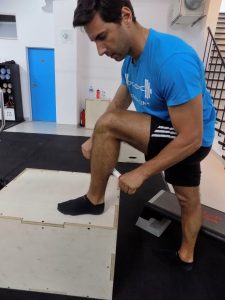
Using a roller stick, look for the trigger points of your calf and massage the inner, central and outer sides of the muscle for 30 seconds in each area. The points that hurt you most are those that need more care. Yes, this exercise might be a little uncomfortable but it’s worth it.
- Glute Bridge with Leg Extension
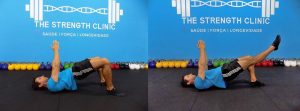
Lying in the supine position, push your heels against the floor, tighten your glutes, and raise your hips to form a glute bridge, with your arms up. Once in this position, extend one leg and form a straight line between the shoulder, hip and heel. Hold this position for 20-30 seconds, always keeping your hips high. Change legs and repeat 5 times on each side.
- Squat with Overhead Arm Reach
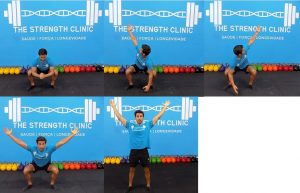
In the squat position (with your heels on the floor and your knees out), raise one arm up, lift the other arm (always looking at your hand) and then raise both arms at the same time and return to the standing position. If you can not squat without raising your heels, you can use a rolled up towel or a board to keep your heels high. Do 2-3 sets and repeat 8-10 times.
- Assisted Squat wiht Medicine Ball
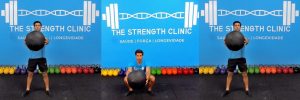
In the standing position, with your feet shoulder-width apart and slightly rotated out, hold a medicine ball (or a bucket full of balls) in front of your body, and begin to slowly lower your body into the squat position by keeping your back straight and without lifting your heels off the floor. Do 2-3 sets and repeat 10-12 times.
I believe that these exercises can be helpful to you, but remember: The swing you can do is directly related to what your body is prepared to do.
See you soon!
Pedro Correia
“Do not judge a man’s strength by the size of his biceps. Things do not always look what they seem.”
– Pavel Tsatsouline
In my opinion a normal human being should aim to be strong. And when I say strong, I’m not talking about those bulked individuals with a strange gait. Anyone (of any age) can become stronger by working consistently for this. Unfortunately, most people are more WILLING to be strong than doing what they need TO DO to be strong. Yes, these are different things. And yes, it’s not easy. One thing is WANTING a top-of-the-range Porsche, another thing is DOING the things needed to have a top-of-the-range Porsche. With strength is the same situation. To be strong, you need to have a plan (or have someone design a plan for you) and to work consistently to execute that plan – this is what your objective should be: to execute the plan. That’s it. You do not become what you THINK about every day, you become what you DO every day. Yes, there are no miracles, no one gets stronger without effort and without spending the time necessary for that to happen. The fitness magazines and the marketing associated with this industry want to make you believe that it’s possible to get stronger or leaner without great effort and quickly. It’s because of these kinds of messages that people still believe in shortcuts and / or allude to the power of genetics. They want it all but they don’t do anything (nothing useful at least). And then they still blame genetics!
There is one thing you should be aware of right now, strength is a skill. And in this sense, strength is the ability to generate more tension in muscles. And that is why strength is the basis for the development of speed, endurance and even flexibility. Like all skills, there are techniques or more appropriate ways to develop it. And that’s what I’m going to share with you. I will teach you some techniques for you to get stronger faster but this will only work if you apply them consistently in training. So, do them! Some of these techniques have already been used with me and with my clients / athletes, so I can assure you that they work and that they are scientifically proven, if that interests you as well. And before explaining them, I want to refer to Pavel Tsatsouline (I love reading his books), since he has been one of the individuals who has shared most of the “Russian secrets” of strength and one of the persons who have inspired me most in this journey. I hope I can meet him someday. Ready? Let’s do it!
- Irradiation
This one is easy, this one any five-year-old understands.
First make a bicep curl set of 5-6 repetitions with good form, keeping the elbow close to the body and without tilting the trunk back. You can use a dumbbell or a barbell. But a serious dumbbell, it’s not worth using Barbie and Ken-style dumbbells, let these tools for people to have fun in aerobic classes! After doing this set, rest for a few minutes and make the following changes: before doing the movement again, i) squeeze hard the dumbbell or barbell; (ii) squeeze your glutes as if you wanted to crack a nut with your buttocks and (iii) tighten your abs and imagine that Mike Tyson will punch you in the stomach.
If you can do these three things, you will realize that the weight will get lighter and you will be able to do a few more reps – in a better and safer way. The explanation is this: when you create tension at various points in the body this will increase total body stability (via the neural impulses produced by the contracting muscles) and this stability / force will irradiate (i.e. spread) to the neighboring muscles as if it were an electric current to start the engine. And the most interesting part lies on the fact that the strength of a particular muscle, for example the bicep, can be amplified if the neighboring muscles also help! Have you realized why in the union lies strength? The formula is simple: more tension = more stability = more force.
- Bracing
Who still does arm wrestling in school? I perfectly remember the times when I was in school and this was one of the games we did in during class breaks or when we had a hole in our schedule. I remember very well the agonizing look of my classmates when they were about to be defeated or their expression of jubilation when I let them gain advantage and then finished strong. Yes, this was fun at the time! And yes, most of the time I won ?.
I gave the example of arm wrestling because I think this is the best way to understand this phenomenon. Lets’ see: an individual who can generate more tension before squeezing his opponent’s hand will have a superior neuromuscular activation level and a clear advantage over an individual who only begins to squeeze when someone (the referee) gives the signal to begin the “combat”. According to Prof. Yuri Verkhoshansky, if we create a sort of pre-tension in the muscles before starting a dynamic contraction, this can lead to increases of up to 20% in performance! Now imagine the advantage you can have if you can apply this technique and if your opponent does not know about it.
Try this technique as follows. Do five normal push-ups and relax on the floor between reps. Then do another five and this time think about creating tension in the whole body, that is, think of squeezing your glutes and abs before pushing against the floor to come up. If you do this well, you will realize that you are much stronger than you thought. Therefore, the key to this technique is in creating tension in the whole body before counteracting resistance. If you do not create this tension before, you will remain weak. Do not be that person.
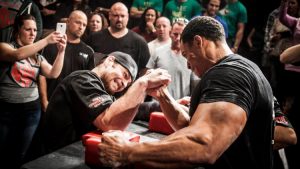
- Power Breathing
First, a few notes on breathing. Proper breathing is very important to maximize performance, a normal person breathes on average more than eight million times a year and it is more likely that he will not do it efficiently. If there was a movement pattern that you had to repeat 23,000 times a day, would you not make an effort to improve it? Think about this a little bit. Most people only use a small percentage of the body’s ability to extract oxygen from the air into the lungs because they tend to breathe only with the upper body (apical breathing), instead of breathing deeper by using the most efficient respiratory muscle we have, the diaphragm (I think we do not talk much about the diaphragm in fitness / bodybuilding magazines because this is an invisible muscle that will not really impress women). But the fact is that this daytime breathing will affect several things: your recovery ability, your anatomical structure, the functioning of your autonomic nervous system, and your cognitive ability. So, if we are talking about performance optimization, be sure to improve your breathing patterns as well.
Second, regarding power breathing, this technique consists of holding the breath during the various phases of lifting. For example, the legendary Bruce Lee used to say that in the martial arts the power of breathing was more important than body strength. In general, the effect of breathing patterns and intra-abdominal and intra-thoracic pressure on strength is strangely ignored or misunderstood by fitness professionals and some medical authorities. These authorities seem to forget that orthopedic injury is much more common than cerebrovascular injury. That traditionally taught breathing pattern of inhaling when we lower the weight (eccentric phase) and exhaling when we raise the weight (concentric phase) may be useful in some cases (and we can’t say that’s wrong) but it’s not the one you want to do when you want to generate as much tension / strength as possible in the muscles. Why? Because the increase in intra-abdominal and intra-thoracic pressure will boost muscle excitability (through the pneumo-muscular reflex) and it is this process that will guarantee more stability in the spine and that will amplify your strength. This is the most natural way to produce strength! Yes, your fitness instructor may have said that forced exhalation of air against the glottis (i.e. the Valsalva maneuver) is hazardous to your health and that you may have a stroke doing this. But is this assertion correct? Prof. Yuri Verkhoshansky and Dr. Mel Siff, two of the world leading authorities on strength training, say the following in this regard in the book Supertraining, one of the strength training bibles:
“For example, the Valsalva maneuver associated with holding breath has a vital role in increasing intra-abdominal pressure to support and stabilize the lumbar spine during heavy lifting… It has been corroborated on many occasions that stress on the spine is decreased during any movement against high resistance and that exhalation during lifting increases the risk of injury to the lumbar spine. Thus, it is unwise to follow popular medical advice that people must exhale during the effort”. The authors further add: “while this may be appropriate for patients with heart disease or hypertension, this same action performed by an athlete who is doing squats or heavy lifting overhead, can seriously compromise spine stability and safety”.
Got it? This means that any healthy person can and should apply this technique if they aim to get stronger and lift heavy loads in a safe way. People with hypertension and heart disease should be more cautious in this regard but please note: this is not to say that they can’t strength train, there are many other ways to develop strength. By the way, it is already well documented in the scientific literature that these people can and should do strength training to improve their condition!
- Successive Induction
Successive Induction, such as the Law of Irradiation we have seen above, is another of the Sherrington Laws exploited to the maximum by the Russians. According to this law, contraction of a muscle – for example, the triceps – will make your muscle antagonist – in this case, the biceps – stronger than normal. In the early 1980s scientists suggested that this technique had a disinhibiting effect and later confirmed that a strength training program that included pre-tensioning an antagonist muscle (i.e. successive induction) was more effective than a program of conventional training. And the most interesting thing is that these benefits were not only limited to an acute performance increase, but also resulted in long lasting strength improvements.
Do the following test. Grab a barbell or free weight and get ready to make a bicep curl set with a load that allows you to do 5-6 solid repetitions. Remember, hold your elbows close to your body and do not lean your trunk back. Do one set and count the number of repetitions you can do with good form. After resting for a few minutes, keep the same weight and do another set, but this time using this new technique. When you bring the weight up, apply the other techniques you already know (irradiation and bracing) and on the descent apply the technique of successive induction, “pulling” the weight down with the triceps. In this way, you will give the biceps some rest on the descent (by preventing them from locking the movement) and will allow the triceps to also have a more active participation in the movement. You should expect to be able to do one or two more reps this way!
Therefore, when applying this technique, you will have two engines controlling the movement. And because of the co-contraction of both muscle groups, this technique may also offer greater benefits in terms of joint stability since the stress on them will be reduced (note: do not forget to discuss this with your doctor if you have joint problems).
Finally, my advice to you is this: if you want to start lifting heavy loads safely begin applying these principles in training (if you can’t do this alone ask someone you know to help you) and enjoy learning one of the skills (i.e. strength) you will need most to optimize your health. And be patient, do not expect to learn all these things from one day to another – it takes time and practice, good practice of course.
See you soon!
Pedro Correia
References
Tsatsouline, P. (1999). Russian Strength Training Secrets for Every American. Dragon Door Publications.
Tsatsouline, P. (2003). The Naked Warrior. Master Secrets of the Super Strong – Using Bodyweight Exercises Only. Dragon Door Publications.
Verkhoshansky, Y; Siff, M.; (2009). Supertraining. Sixth Edition – Expanded Version. Ultimate Athlete Concepts.
Verstegen, M.; Williams, P. (2014). Every Day is Game Day. Penguin Group.
“We don’t believe there is one way to swing a club; we believe there is an infinite number of ways to swing a club. But we do believe there is one efficient way for all golfers to swing a club and it is based on what they can physically do.”
– Titleist Performance Institute
If you’re reading this, you’re probably interested in improving your physical condition to make more birdies, hit longer drives, and increase your longevity as a golfer. Or, perhaps, your goal is to become the best player in your club or win the next Match Play Championship. No matter what your motivation is, the fact is that if your goal is to improve your game, this will require you to prepare yourself a bit better than most golfers I know. And better does not necessarily mean training longer hours!
If you´re still one of those players who spends hours and hours hitting buckets of balls on the driving range hopping that this will help you improve your golf game, you need to change your strategy. Hitting buckets of balls in the driving range and making chips and putts is not enough. If you truly want to improve your performance in this sport, your practice needs to include general athletic development exercises and specific physical training for golf, in a progressive and periodized manner.
This means that what you normally see in the gym has nothing to do with what you need to do to hit farther, straighter and to go through the 18 holes without getting so tired.
First: Is your swing efficient?
The only way to determine whether your golf swing is efficient or not is through a 3D Biomechanical Analysis. What we can see in the traditional video imaging used by most golf professionals / teachers is just the swing style. There are many golfers who do not have a particularly attractive swing (e.g. Raymond Floyd, Jim Furyk or John Daly) but the reason why these players were or are successful is because their swing is efficient. Having an efficient swing for a golfer means transferring energy (without leaks) through the feet, knees, hips, spine, shoulders, arms, wrists down to the club head and ultimately to the ball. With the data obtained through the 3D system, we can check the kinematic sequence of each player, that is, we can measure the speed of rotation of each body segment involved in the execution of the golf swing and determine if each segment is accelerating and decelerating correctly.
When we look at Jim Furyk and Ernie Els swing through video analysis (and through the naked eye), we can see that both swings are quite different from each other, however, when we look at the kinematic sequence of each player, we find that it’s difficult to see a significant difference between the two swings. This means that although Ernie Els and Jim Furyk have completely different swing styles, they both share the same kinematic sequence.
All great players start by generating speed from the hips and transferring that energy through the torso, arms and club. This is the efficient sequence in the downswing.
The golf swing is a complex multi-dimensional movement that involves a highly coordinated action of the entire kinetic chain (feet, knees, hips, spine, shoulders, arms and wrists) and takes less than two seconds. The golf swing is therefore a ballistic movement which, in order to perform efficiently (i.e. with a correct kinematic sequence), it’s necessary that the various body segments are properly prepared to deal with the inherent shear and rotation forces in this movement. Hence the importance of what follows.
Second: The Physical Assessment in Golf
Before we get to the physical training itself, it’s important to know what your physical limitations and asymmetries in terms of movement are (one of the main causes of injury). Because of this, it’s essential that you perform a functional assessment for golf, preferably with a qualified professional that knows what he’s doing. In the same way that you go to the doctor for exams to find out how your health markers are, you should also do an initial assessment with a golf fitness specialist to find out how your body behaves during a golf swing and which are the main limitations / compensations.
The physical evaluation in golf consists of performing several tests in order to measure the functionality of the body movement patterns necessary for golf, that is, the measurement of various indicators of its stability, mobility, balance and various performance parameters such as strength, power and cardiovascular capacity.
This type of assessment is the starting point for playing better and for preventing injuries. If you still think that your body is fine and that you don’t need any intervention at this level, you’re more likely to be wrong. Our body was not designed to lead the way we live today, so you can be pretty sure there are things in your body that need some work. If you still do not believe me, think of golfers you know who have never complained of back pain or pain in another part of the body (wrists, shoulders, elbow).
Your body is the determining piece of equipment in your game. The quality of the clubs, balls, gloves, shoes and the latest drive or putt on the market, are certainly not the most important aspects. I still see many golfers too preoccupied with the new gadgets and the style of clothing, when in fact these are not the most important things to get more birdies. What will, in fact, bring you better results is improving your body’s functional skills to hit the ball more efficiently and safely.
Final Remarks
Many players fail to perform an efficient golf swing not only because the movement itself is complex but also because their bodies are not properly prepared to deal with the forces generated during the movement.
Keep this in mind the next time you hit balls or have a lesson with your golf teacher, maybe that’s why you can’t do what your teacher asks you to do. There is no point constantly insisting on improving technique if there is no synergistic effort in improving physical skills. The swing you can perform is directly related to what your body is prepared to do – think of the golf club as an extension of your body.
In the next articles I will share the most common characteristics in this relationship between the body and the golf swing and suggest some exercises so that you can improve your performance on the golf course.
Stay tuned!
Pedro Correia
If you still exercise to “burn calories,” you have not yet realized the purpose of a physical training program and the importance that movement has in our lives. The least important thing about exercise is the number of calories you burn! And that’s what I’ll try to explain in this article.
The power of exercise goes far beyond calorie burning, caloric expenditure is just a (nice) side effect of the type of exercise we do. Exercise consists of potentiating the release of powerful molecules and hormones that “talk” to our body’s organs (it’s not just food that has this kind of influence), and that determines what’s going to happen. And usually, the higher the intensity, the more beneficial the hormonal response.
Therefore, a well-designed physical training program has more to do with increasing energy levels, movement precision, vigor, muscular strength, mobility, agility, speed, work capacity and with an improved hormonal profile.
The Calorie Fever
I still see a lot of people worried about the calories in their food, the calories they burn when they exercise, the calories they consume each day, and I ask: How did we get here? What kind of message is being propagated that made people so obsessed with calories? Is calorie counting that important? Let’s see.
In order to discover the amount of energy in food, scientists burn food samples in a bomb calorimeter. And, to my knowledge, a bomb calorimeter does not share the same physiology and genetic makeup as a human being. As far as I know, a bomb calorimeter does not depend on the functioning of the various systems in the human body which are the real players in the way energy is absorbed and used (examples: digestive, endocrine and nervous system). This way of thinking is most likely unsustainable and ineffective long-term. This way of thinking is too reductive and does not solve the main problem – people’s lack of education regarding the importance of what we eat throughout our lives. Is it just me who finds it strange that most people are more concerned about their cell phones, cars and computers than with the origin and composition of the food they eat?
In fact, just look around and you’ll acknowledge that this is not the path to follow!
It is true that if we have the goal of losing fat mass, we must create an energy deficit, that is, the balance between the amount of calories (energy) entering our body and the amount of energy (calories) burned, must be negative. That’s the number one rule in rigid weight loss programs and that’s why we see Biggest Loser contestants training several times a day.
(Note: I should remind you that the Biggest Loser is a contest in which the goal is to lose weight in the shortest time possible, it’s not a contest to see who gets out of there healthier – if this was the goal probably there was no audience).
However, there is a lot more to be said. There are good calories and bad calories. The foods we eat, besides having a certain number of calories (which can be very difficult to determine with accuracy and can be highly variable), also have different properties with respect to their composition of macronutrients (protein, fat, carbohydrates) and micronutrients (minerals, vitamins, phytochemicals). These bioactive properties and compounds are what makes the difference and what should be studied preferentially. In my way of looking at things, it is more logical to first check the functionality of food (i.e. how its nutrients work) and then look at its caloric density, which can also be more or less functional depending on the objectives, morphology and specific conditions of each individual.
(Note: If you still think low fat diets are the most suitable for weight loss check the following study published in 2003 in the New England Journal of Medicine here, where it was shown that people on a high-fat diet lost more weight as those on a low-fat diet, the diet generally recommended by leading health organizations. But, of course, adherence to the diet will be the most important factor).
Back to calories…
Because the absorption of these nutrients will depend on the functioning of our digestive system – which in turn is governed by the endocrine system (think of hormones) and the nervous system (think of neurotransmitters) – and the health of the organs involved in the digestion process (mouth, esophagus, stomach, pancreas, small intestine, large intestine, liver, gallbladder), it becomes easy to understand that the web of relationships in the human body is much more complex than simple calorie counting. Albert Einstein has a quote that fits perfectly here: “make everything as simple as possible, but not simpler.”
The Power of Exercise
Anyone that is minimally informed about exercise already knows that long distance aerobic training is not the best choice for improving body composition and may even have opposite effects (catabolic effects) due to the pronounced increase in cortisol levels.
This has been known for a long time but it’s always important to remember. This study published by Tremblay, Simoneau and Bouchard in 1994, showed that the group that did 15 weeks of interval training burned NINE TIMES more fat than the group that did aerobic training. And this was in half of the time period!
What you need to “burn calories” is to increase the intensity of your workouts for certain periods of time, it’s this type of stimulus that will increase your metabolism and accelerate fat loss. In this study, a 30-minute training session of metabolic resistance training caused a 38-hour increase in metabolism – the famous afterburn effect or EPOC (post-exercise oxygen consumption). Let’s put this into perspective. Let’s say you trained this way on Friday morning. With this training method your body will still be in a “fat burning” mode on Saturday night, when you’re having dinner with your friends or with your boyfriend / girlfriend.
And why do I insist on combining a good diet with good training? Because I’m aware of the evidence on this topic. This study from 1999 showed that those who did aerobic training and strength training on a low calorie diet burned 44% more fat than those who merely followed dietary guidelines. As I’ve been saying, diet is the most important component for those people who want to lose fat, however, once that aspect is assured, only strength training and interval training can actually bring your results to a higher level. In my opinion, the fact that this study was based on a low-calorie diet combined with aerobic training is limiting, but we have to bear in mind that these are usually the guidelines of the American College of Sports Medicine (ACSM). The guidelines are intended to facilitate nutritional guidance offered by practitioners, but unfortunately that is not what I have observed when I discuss these issues with some colleagues.
I think you have already realized that the type of training you do can be a great ally to put your body in an energy deficit and consequently in fat burning status. Now I will try to explain why this is the least important of all. Stay with me!
Like nutrition, physical exercise is key to improve health, performance and body composition. You’re probably tired of hearing this. But it’s not any kind of physical exercise that works. Doing hundreds of crunches to lose belly fat, using all the gym machinery, running 10 miles a day, doing Pilates twice a week and doing 100 power cleans in the shortest time possible is not enough. You can call it physical exercise if you want, but it’s not just this kind of physical exercise our body needs. A more comprehensive approach is needed.
We need Good Movement (we shouldn’t start running in the first place)
The concept of “move more for your health” is insufficient for our real needs and to improve quality of life. We need good movement, we need to acquire movement competency in the first place. I am talking about the ability to perform fundamental movements with good form. Fundamental movement patterns such as squatting, hinging, pushing, pulling, throwing, carrying, walking, running and jumping.
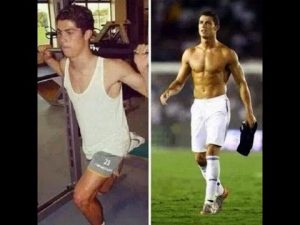
From my point of view, running should be the last step in this process and yet what we most frequently see is people running all crooked and with an obvious deficit in muscle strength. But the problem is not theirs, they are trying to do something for their health (and probably that’s all they know), the problem is that most of them are not aware that running is a skill, which requires preparation, practice and training. Cristiano Ronaldo did not become the best player in the World over night, it took many hours of training (in the field and in the gym) to reach this level. Although it’s relatively easy and affordable for anyone to put on their shoes and just go out for a run, running also requires preparation, practice and training (technical and physical).
It is necessary to have stability, mobility, strength (every step we take on the ground is subject to the action of gravity and the speed we run, generating reaction forces of 2 to 5 times our body weight), symmetry, quality of movement and good musculoskeletal health. Running to get healthy or fit is one of the greatest physical distresses on our body if we don’t have a solid foundation. First, you need to be in good shape to run. If you don’t hone good movement skills, you are more likely to get injured. According to the available literature, the incidence rate of injury in runners may exceed 90%, this is more than any other sport. Plantar fasciitis, stress fractures, patellar tendonitis and patellofemoral pain are just a few examples. Check this systematic review if you’re interested in learning more.
Again, don’t get me wrong, I’m not anti-running and I admire the effort and suffering capacity of all runners. I think we should all be able to run (by the way, that’s how we evolved as a species), the problem is that most people who run are not properly prepared to run and there are fundamental learning steps that should not be overlooked in order to prevent structural imbalances in the musculoskeletal system and injuries. Cleary the simplistic idea of “move more” is not enough.
A new way to look at training
Different types of training can affect the way our genes work and how they interact with our cells. With good training it’s possible to decrease chronic inflammation, improve insulin sensitivity, strengthen the cardiovascular system, improve lipid profile, slow down normal aging, burn fat (as we’ve seen in more detail above), increase confidence and self-esteem, increase energy levels, increase mental strength, improve a number of physical skills that we need for our daily life activities or sports practice (such as strength, stability, mobility, balance, speed, agility) and our different energy systems (ATP-CP, glycolytic, and oxidative). As we age, these skills naturally decline, but the fact is that with a more comprehensive training program it is possible to reverse and / or at least mitigate this decline.
Most people think that genes are the brain of the cell, they believe that if genes don’t tell you what to do, the cell dies. But if you remove the genes from the cell, the cell is still alive, eliminating waste products and behaving just like another cell. So, instead of genes being the brain of the cell, think of genes as your instruction / repair manual. When a worn part of the cell needs to be repaired or when new substances need to be produced, genes will give instructions for doing so.
Every cell in our body is surrounded by a fatty membrane, which is filled with thousands of receptors. These receptors receive information from different parts of the body and pass this information into the cell to form / encode new proteins, burn more or less fat, etc. (Note: this is why it’s important to eat good fats and avoid the hydrogenated fats present in most processed foods so that the cell membrane is more permeable to nutrient delivery.) It’s this membrane with receptors the cell command center so if we remove these membrane receptors, the cells die. This means that cell function is highly influenced by external factors, namely through hormones and other molecules that bind to these receptors.
These messenger molecules are not randomly created by our body, they are created according to our lifestyle, diet, thoughts, behaviors, temperature, light, sound and… our type of training. It’s possible to be born with some defective genes – for example BRCA 1 and BRCA 2, which increase the risk for breast cancer – but it’s these messenger molecules / hormones that will determine the degree of activation of these genes. Therefore, controlling these hormones means controlling the body.
(Note: Don’t you find it strange that almost 90% of health care costs is related to treat health conditions, while 80% of health problems / diseases arise as a consequence of our lifestyle and the environment we’re exposed to? Check this TED talk from Dan Buettner to realize why we are walking in the wrong direction).
High-intensity exercise is the one that induces a more favorable hormonal environment, with an increase in hormones such as testosterone, growth hormone and IGF-1, interleukins with an important role in inflammation (IL-6), muscle tissue maintenance (IL-15) and growing of new blood vessels (IL-8), lactic acid (which has the ability to keep us young by stimulating the release of testosterone and growth hormone) and nitric oxide, a vasodilator which plays a key role in regulating blood pressure, muscle strength and erectile dysfunction. Unfortunately, long running does not produce the same effects. Compound movements, which require a combination of strength and stamina, in short periods of time, are those that will put your muscles to “talk” more with your body. Burning calories is only a minor side effect when compared to the amount of hormones and other signaling molecules that influence how our body works.
To be clear, we are talking about intensity coupled with movement quality. Intensity coupled with bad movement will have the opposite effect: INJURY.
Conclusion
It’s urgent to give rise to a new mentality on training the movement skills that we will need throughout our lives. And this is a serious limitation of most group classes in conventional gyms. The instructors are obliged to follow a certain beat and choreography. Individualized feedback is almost non-existent. People don’t have time to understand or to learn the movements. And no one learns anything if they don’t know what it’s for, no one learns anything if they don’t understand how it’s supposed to feel and its practical implications. In addition, most machines in gyms annihilate the sensory and body perception that we, humans, need. We live in a three-dimensional world, in a world of constant adaptation and spatial exploration, so it makes no sense that machines and choreographies of group classes dictate the rules of our movement.
And why is it important to learn efficient movements? First, an efficient movement happens when a body is able to produce force through a coordinated action between the various body segments without energy leaks and demonstrating a natural ability to exploit maximum range of motion. Second, it’s movement that will allow you to play more time with your children, change the furniture at home, improve your day-to-day performance and your performance in your recreational activities.
Look at this type of training as the foundation, the support you need to get stronger, faster, smarter, more agile, more competent in a series of physical attributes that will allow you to perform better in the activities you enjoy doing. Would you like to start playing tennis? golf? volleyball? Would you like to start surfing? paddle board? weightlifting? powerlifting? dance? climbing? triathlon? Would you like to be faster when you play football with your friends during on weekends? Obviously, each modality has its specific abilities, but they all share the same foundation: human being’s adaptability capacity. To improve these specific skills safely, you first need to improve your fundamental movement patterns. And to sustainably keep improving these fundamental movement patterns, you need to train better and respect the developmental stages of each one.
To sum up, the great advantage of better training (and I remind you what we learned about the power of exercise, good movement and a new way of looking at training) is to improve your quality of life, maximize your performance and, above all, giving you the freedom and autonomy to choose the activity / sport that you always wanted to try but never had the courage or opportunity to start off.
Think about these things next time you go to the gym to walk on the treadmill with your headphones on and watch some TV series for 40 minutes while looking at the calories burned on the monitor and at the workouts or exercises other people are doing.
See you soon!
Pedro Correia
References
Berardi, J, Andrews, R. The Essentials of Sport and Exercise Nutrition. Certification Manual. Second Edition. Precision Nutrition Inc. (2013).
Björntorp P. Hormonal control of regional fat distribution. Hum Reprod. 1997 Oct;12 Suppl 1:21-5. Review.
Frederick F. Samaha, M.D., Nayyar Iqbal, M.D., Prakash Seshadri, M.D., Kathryn L. Chicano, C.R.N.P., Denise A. Daily, R.D., Joyce McGrory, C.R.N.P., Terrence Williams, B.S., Monica Williams, B.S., Edward J. Gracely, Ph.D., and Linda Stern, M.D. A Low- Carbohydrate as Compared with a Low-Fat Diet in Severe Obesity. N Engl J Med 2003; 348:2074-2081.
Gary D. Foster, Ph.D., Holly R. Wyatt, M.D., James O. Hill, Ph.D., Brian G. McGuckin, Ed.M., Carrie Brill, B.S., B. Selma Mohammed, M.D., Ph.D., Philippe O. Szapary, M.D., Daniel J. Rader, M.D., Joel S. Edman, D.Sc., and Samuel Klein, M.D. A Randomized Trial of a Low-Carbohydrate Diet for Obesity. N Engl J Med 2003; 348:2082-2090.
Houston, M. What your doctor may not tell you about Heart Disease. Grand Central Life & Style (2012).
Kraemer WJ, Volek JS, Clark KL, Gordon SE, Puhl SM, Koziris LP, McBride JM, Triplett- McBride NT, Putukian M, Newton RU, Häkkinen K, Bush JA, Sebastianelli WJ.
Influence of exercise training on physiological and performance changes with weight loss in men. Med Sci Sports Exerc. 1999 Sep;31(9):1320-9.
Schuenke MD, Mikat RP, McBride JM. Effect of an acute period of resistance exercise on excess post-exercise oxygen consumption: implications for body mass management. Eur J Appl Physiol. 2002 Mar;86(5):411-7. Epub 2002 Jan 29.
Tremblay A, Simoneau JA, Bouchard C. Impact of exercise intensity on body fatness and skeletal muscle metabolism. Metabolism. 1994 Jul;43(7):814-8.
van Gent RN, Siem D, van Middelkoop M, et al Incidence and determinants of lower extremity running injuries in long distance runners: a systematic review British Journal of Sports Medicine 2007;41:469-480.
This is an article on a topic that is very special to me. I’m going to talk about myself, about music, about musicians, about sports and about physical preparation.
I will explain how it is possible to play at the highest level for many, many years in a healthy way and without having to practice endless hours of scales with perfect technique. I will explain how it is possible to avoid tendinitis and other musculoskeletal injuries that typically affect musicians sooner or later, which result from long hours of practice of repetitive gestures in very “unnatural” positions. Yes, it is possible to avoid, mitigate or even eliminate pain in your back, shoulders, neck, elbows, wrists and fingers, which are so common among professional musicians.
Me and music …
Those who have known me for less than 10 years probably don’t know, but I have had a career as a professional musician for at least the previous 10 years. I’ve started playing bass guitar and at a certain point I switched to double bass. I’ve studied at several schools in Portugal (Lisbon Conservatory, Lisbon Superior School of Music and Hot Club of Portugal Jazz School where I would become a teacher) and graduated from the Conservatory of Amsterdam. I was in fact obsessed with playing double bass and particularly obsessed with playing it with perfect technique! I used to practice a reasonable number of hours a day and was able to subject myself to incredibly boring exercises for many hours in a row, just because I wanted to improve a certain aspect of my performance. I could practice about 10 hours a day. For the less familiar with music instruments, the double bass is a very physically demanding instrument, and 10 hours of repetitive gestures in unbalanced positions is very stressful on the body.
Due to long hours of musical practice, I developed a debilitating neuromuscular pathology (focal dystonia) that led me to a long rehabilitation process and to put my music career on hold. To know what focal dystonia is follow this LINK. In addition to focal dystonia, the list of complaints included:
- Frequent back pain, particularly in the lower back;
- Pain and stiffness in the neck, the sensation of having a wry neck that never went away;
- A thoracic kyphosis already up to a non-physiological degree;
- Protruded (forward) shoulders;
- Uneven hips. Because I spent many hours standing leaning mostly over my right leg and in slight lateral flexion, my pelvis was tilted to that side, just like my torso and shoulder. In fact, my right side was all “shortened”, as if I had one leg shorter than the other, which anatomically does not occur;
- Highly rigid and weak wrists, hands and fingers. For instance, I could not hold a push-up position on the floor with arms straight and shoulders over the hands, because my wrists would hurt and did not extend enough.
To aggravate all these imbalances caused by specific and repetitive gestures, my choices for physical activity (yes, because my past in sports impelled me not to be sedentary) relied on activities that were also specific and that also included repetitive gestures, that is, I would play sports! By definition, any sport and its related gestures are specific, cyclic, repetitive and asymmetric. There are sports “less bad” than others, but they are all asymmetrical. And no, swimming is not a complete sport, none is!
All this, and particularly the highly traumatizing and time-consuming process of neuromotor retuning that I underwent to treat dystonia, has prompted me to better understand processes related to the neuromuscular function, motor control, and musculoskeletal injuries. I decided to go back to the university and start a new career, and discovered other obsessions: anatomy, physiology, nutrition, strength training. And here I am today!
Musicians and the myths about “frailty” of their fingers and body …
I have to acknowledge, and my musician friends must forgive me, but musicians are usually very lazy to do any physical activity. We live to play our instruments and to be available for rehearsals. We make up excuses such as not having time and / or that our working tools (e.g. hands and fingers) are very “sensitive” and prone to injury if we engage in any vigorous physical activity. The fear of twisting a finger or cutting a lip (for wind instrumentalists) or even a foot (for drummers) is understandable! In fact, a finger injury for example may be enough to impede a musician from working for several weeks.
Who hasn’t witnessed or lived the situation where when playing soccer with friends those who are musicians try to avoid playing as the goal keeper with fear of injuring their fingers? Perfectly legitimate and understandable. And it’s precisely for this reason that if musicians want to get in better shape and ensure they can play music without injuries for many more years, doing sports is not the solution. They can do it for pleasure, and the energy expenditure that results from it can have positive metabolic effects. However, all asymmetries and musculoskeletal injuries that result from playing an instrument will not be corrected by playing a particular sport and will most likely will be worsened.
Musicians should do general physical preparation instead! Because a professional musician is a highly specialized high-level athlete. A high-level athlete practices his sport and in his training program is (or at least should be) included a very important component which is basic physical preparation. In his physical preparation program our athlete trains for strength, mobility and endurance, and other physical qualities in order to establish a general athletic base that will make him more resilient and protect him from injuries that his sport, which is repetitive and asymmetrical, makes him vulnerable to.
We don’t get fit FROM PLAYING sports, we should get fit TO PLAY sports. The repetition of specific sports gestures induces specific musculoskeletal adaptations. It is easy to understand that for an athlete, it does not make sense to try to compensate for a specific adaptation induced by a sport gesture with another one which might apparently look as an opposite one! For example, will it be smart for a right-handed tennis player to try compensating for the asymmetries resulting from playing with his right arm by engaging in the practice of table tennis with his left arm? Or, if our player exhibits pain in the right shoulder associated with lack of flexibility and strength, does it make sense to start practicing gymnastics just because apparently gymnasts have strong and flexible shoulders? No and no! This athlete should follow a program of general physical preparation to become stronger and more mobile, which can in fact compensate for the asymmetries induced by the sport that he practices.
What is the similarity between playing an instrument and practicing a sport? It’s the same…
Imagine compensating for the unbalanced position of playing double bass with playing another instrument in a seemingly opposite position?
Let’s explore that idea…
For example, playing double bass (a string instrument that can be played with a bow or fingers of the dominant upper limb) implies (usually) standing in a position characterized by unilateral rotation and flexion of the torso, accompanied by a forward leaning of the trunk, in a bipedal position with greater weight over the side of the torso’s lateral flexion, with elevation of both non-dominant arm and shoulder paired with depression of both dominant arm and shoulder, and rotation and slight lateral flexion of the head.
So, to compensate for or correct all these adaptations will it make any sense to go play the violin for example? Because apparently, it’s the opposite! You are (usually) sitting and not standing, the rotation and flexion of the head is in the opposite direction, where both dominant arm and shoulder are apparently more depressed, and the dominant arm raised …? Of course not…
By the same token, this musician will not be stronger, more flexible and more resilient to injuries due to his musical practice if he chooses to compensate for these adaptations with the practice of a sport. If you enjoy playing football or tennis with friends, you should do so, but it will not make you more resilient to injuries or attenuate the ones you may already have.
You must go to the basics: physical preparation.
Musicians should follow physical preparation program such as an athlete. Playing an instrument is highly specific and doing it regularly and long-term will require some specificity and in terms of exercises that can compensate for those unnatural positions that are held for such long periods of time. Yet, the basis of physical preparation will always be (for the athlete, musician, or any other) of a general nature. It is necessary to make the body stronger and more flexible, because only that way one can make it more resilient in order to endure the highly demanding physical requirements of playing a musical instrument for hours, days and years on end.
The pain and discomfort that you my fellow musician feel now, can improve with physical training! Smart training in a controlled environment. A kind of training that can make all the structures of our body stronger and less rigid. A kind of training that promotes a better alignment of the kinetic chain and that enables you to produce force in fundamental movement patterns such as pulling, pushing, lifting objects off the floor, squatting, crawling, walking and jumping.
And no, your body is not fragile! If it hurts, it’s because it’s somehow weak!
Believe me, I’ve been there, done that… ?
Whatever the sport, strength training, in harmony with various training factors (i.e., technical, tactical, physical and psychological) and training principles (i.e., overload, specificity, reversibility, heterochronism, specialization, continuity, progression, cyclicity, individualization and multilateralism) will endow the athlete with a complete set of tools in order to maximize performance.
In tennis, strength is used to generate speed, power and endurance. It is impossible to have agility, speed, power, a developed anaerobic system, and flexibility / mobility without optimal strength levels (Verstegen, 2003). Strength training is also critical to prevent injury. Because tennis is a sport that involves many repetitions of movements of unilateral features, it is conducive to developing muscular imbalances which significantly increase the likelihood of injury. In tennis, the highest incidence of injuries is in the shoulders and back, followed by injuries in the elbows, knees and ankles (Kibler & Chandler, 1994). Thus, specific strength training for tennis is essential to maintain or restore proper muscle balance.
Definition of Force
The definition of force based on its purely mechanical concept consists of any cause capable of modifying the state of rest or motion of a body, consisting of a vector with a given magnitude and direction. It is the product of mass by acceleration (F=m*a). Although this definition of force is unanimously accepted, it hardly illustrates the different components of muscle strength. That is, if we understand muscle strength as an essential component for the development of motor skills which consists of the ability to apply force to overcome resistance (O’Sullivan & Schmitz, 1998).
Why Strength Training in Tennis?
A strength training program in the context of tennis should aim at developing “highly innervated muscles with an explosive ability” so that players can serve with greater speed, so that they can put “more weight” on the ball (due to an improved use of ground reaction forces), so that they can cover more area on court (because they are more agile and fast), and so that they feel as if they “float” on the court the whole day and week (Verstegen, 2003). It is important though to dispel some myths regarding strength training, namely that this type of training will make players slower, less agile or tight. Only poorly designed strength training programs will lead to this. In fact, several studies show that amongst Olympic athletes, weightlifters are those displaying the highest levels of power and are second best (after gymnasts) regarding flexibility levels (Jensen & Fisher, 1979).
It has been well established that adequate strength training not only maintains levels of flexibility but can actually significantly increase them (Fox, 1984; Jensen & Fisher, 1979; O’Shea, 1976; Rash, 1979). Also, adequate strength training induces significant improvements in: work capacity; body composition (i.e., lean mass gains and loss of fat mass); energy efficiency; tissue growth hormonal secretion profile favoring protein synthesis (e.g. strength training induces growth hormone secretion and testosterone); posture; and muscle balance (Lamb, 1984; Stone et al., 1982).
Specifically in tennis, it has been shown that strength training strengthens the immune system (thus protecting the player from injury and illness), and is often pointed to have a positive psychological effect on players, since it appears to be coupled with an increase in levels of self-confidence during matches (Folkins & Sime, 1981; Tucker, 1983), as out of the game (Folkins & Sime, 1981).
The Various Types of Strength and Its Application in Tennis
- Strength endurance: the ability to produce force over time while resisting to fatigue. Good strength endurance levels allow the maintenance of proper form and a correct technical execution. Together with the static strength, strength endurance makes a sort of a basis for developing other types of strength training in tennis.
- Static strength: the ability to stabilize joint structures allowing better transmission of energy along the kinetic chain, i.e. without loss of energy. In tennis, this type of strength allows optimal use of force generated against the ground to subsequently transfer speed to the ball.
- Maximal strength: relates to the maximal force value during a voluntary contraction against an immovable resistance. It is mainly a strength assessment parameter and we can consider its absolute and relative measures (i.e. relative to body weight). For tennis, relative strength is more relevant than absolute strength because it has a direct influence on the player’s speed and agility. Strength Deficit (SD) should also be evaluated based on measures for Maximum Eccentric Force (MEF) and Maximum Isometric Force (MIF). The SD = MEF-MIF. If the SD > 25% for the lower limbs, and SD > 50% for the upper limbs, training should prioritize Rate of Force Development (RFD). If below these values, strength training should focus on hypertrophic and maximal strength methods.
- Power – the ability to produce the most amount of force in the shortest time interval. It includes:
- Starting strength (up to 250ms of the force / time curve) –expressed as the Initial Force Production Rate (IFPR) and reveals the ability to accelerate from a static position (i.e., velocity = 0);
- Explosive force (above 250 ms of the force / time curve) – expressed as the Maximum Force Production Rate (MFPR) and reveals the ability to accelerate to maximum force levels. It is one of the main indicators of performance in tennis. It corresponds to the phase of maximum acceleration during a given movement;
- Reactive force – force produced during muscle’s stretch-shortening cycle (SSC). The use of the elastic and reflex properties of the muscle present in the SSC influences the IFPR and the MFPR. Reactive force training (i.e., using muscle’s SSC) may contribute to increased acceleration capacity, that is, increasing IFPR and the MFPR, and consequently gains in power.
- Optimal Strength (Verstegen, 2003): the combination of the types of strength described above according to aspects inherent to the player and his/her performance, such as: age; capacities; style of playing; stage of development; type of surface on which they will play.
Table 1 specifies the ideal characteristics of strength training in tennis for the various stages of development according to the Long-term Athletic Development model (Balyi & Hamilton, 1999).
| Table 1. | |||
| Age | Characteristics | ||
| 6-9 Boys 6-8 Girls | Strength training should focus on exercises with body weight. It may include the use of medicinal balls (of adequate weight) in exercises of a playful nature. The strength gains at this age are mainly attributed to gains in motor coordination and neuromuscular activation. | ||
| 9-12 Boys 8-11 Girls | Strength training should be regular and lead to progressive improvements. At this stage, however, emphasis should be placed on motor learning and development. | ||
|
12-16 Boys 11-15 Girls | Strength training should be characterized by short sessions (less than 30 minutes) two to three times a week. The Peak Height Velocity (PHV) will determine the increase in volume and intensity of the loads. Critical periods for strength training will occur shortly after PHV for girls, and 12-18 months after PVA for boys. Basic Olympic lifts techniques should be introduced and mastered during the PHV. This can constitute an important training tool “in the box” for later development high levels of power, as well as preventing injuries and optimize adaptation to strength training. | ||
| 16-18 Boys 15-17 Girls | Strength training should be regular and lead to progressive improvements. Regular assessment of strength deficit should be made to determine if training should be more hypertrophy or RFD oriented. It should have a special emphasis on possible muscular imbalances due to the higher levels of intensity and volume related to tennis training and tournaments | ||
| Adulthood | The training should be regular and lead to progressive improvements. However, training should spot imbalances, inadequacies and weak points of the athletes in order to optimize performance in tennis in the long term. | ||
Conclusion
In short, a strength training program should consist of integration of stability and recovery / corrective exercises, together with strength work of both maximal and explosive characteristics, as well as court work focusing strength components such as speed, agility and power.
References
Balyi, I. & Hamilton, A. (1999). The FUNdamentals in Long-term Preparation of Tennis Players. In N. Bollettieri (Ed.). Nick Bolletieri Classic Tennis Handbook, (pp. 258-280). New York: Tennis Week.
Folkins, C. H. & Sime, M. E. (1981). Physical training and mental helath. Journal of Physiology, 36, 373-389.
Fox, E.L. (1984). Sports Physiology (2nd edition). Philadelphia: W.B. Saunders.
Jensen, C. R. & Fisher, A. G. (1979). Scientific Basis of Athletic Conditioning. Philadelphia: Lea & Fegiber.
Kibler, W. B. & Chandler, T. J. (1994). Raquet Sports. In F.Fu &D. Stone (Eds.), Sports injuries: Mecahnisms, Prevention, and Treatment. Baltimore: Williams & Williams.
Lamb, D. R. (1984). Physiology of Exercise (2nd edition). New York: MacMilan.
O’Shea, J. P. (1976). Scientific principles and Methods of Strength Fitness (2nd edition). Reading: Addison.Wesley.
O’Sullivan, S. B. & Schmitz, T.J. (1998). Strategies to improve motor control and motor learning. Physical Reabilitation: Assessment and Treatement (3rd edition) (pp.225-244). Philadelphia: F.A. davis.
Rasch, P. J. (1979). Weight Training (3rd edition). Duduque: Wm. C. Brown.
Stone, M. H., Byrd, R., Carter, D. et al. (1982). Physiological effects of short-term resistive training on middle-age sedentary men. National Strength and Conditioning Association Journal, 4, 5, 16-20.
Tucker, L. A. (1983). Self Concept: Afunction of self-perceived somatotype. Journal of Psycology, 113, 123-133.
Verstegen, M. (2003). ITF Strength & Conditioning for Tennis. In M. Reid, A. Quinn, & M. Crespo (Eds), Developing strength (pp. 113-135). London: ITF Ltd.

